




By Alexzia Shobe Staff Writer
n a time marked by profound social upheaval and in a state that research indicates is among the worst places for Black people to live given its profound racial disparities, Leesa Kelly stands out as a uniting voice for the Black community.
As the founder of the grassroots group Memorialize the Movement (MTM), Kelly dedicated herself to preserving the murals created in the wake of George Floyd’s murder in 2020. Four years have passed, but she knows there is still much work to be done.
Among that work is an exhibit and corresponding catalog memorializing Floyd. “Art and Artifact: Murals from the Minneapolis Uprising” is a collaboration between Kelly and Howard Oransky, director of the Katherine E. Nash Gallery at the University of Minnesota. The exhibit runs through Dec. 7.

The corresponding catalog opens with a quote by Ida B. Wells: “Let the facts speak for themselves, with you as a medium.” What follows is a collection of essays and murals that respond dynamically to that rallying call.
“Art and Artifact” is more than just a catalog; it is a curated collection of catharsis, reflection, and the demand for justice. The bound volume features 100 full-page color images and es-
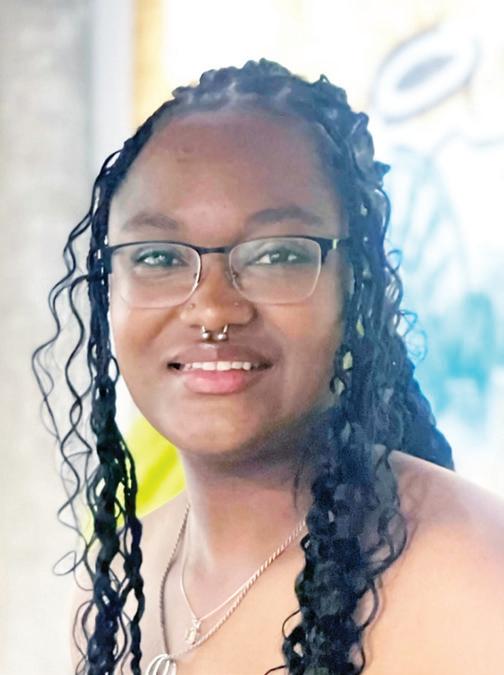
says contributed by Kelly, former MTM and K.E. Nash Gallery intern Amira McLendon, and curators Leslie Guy and Seph Rodney. McLendon, now MTM’s collections manager, also curated the gallery exhibit. Together, they document a vibrant artistic response to systemic racism and police brutality, offering readers a glimpse into the collective grief and resilience of a community determined to
■ See FLOYD on page 5
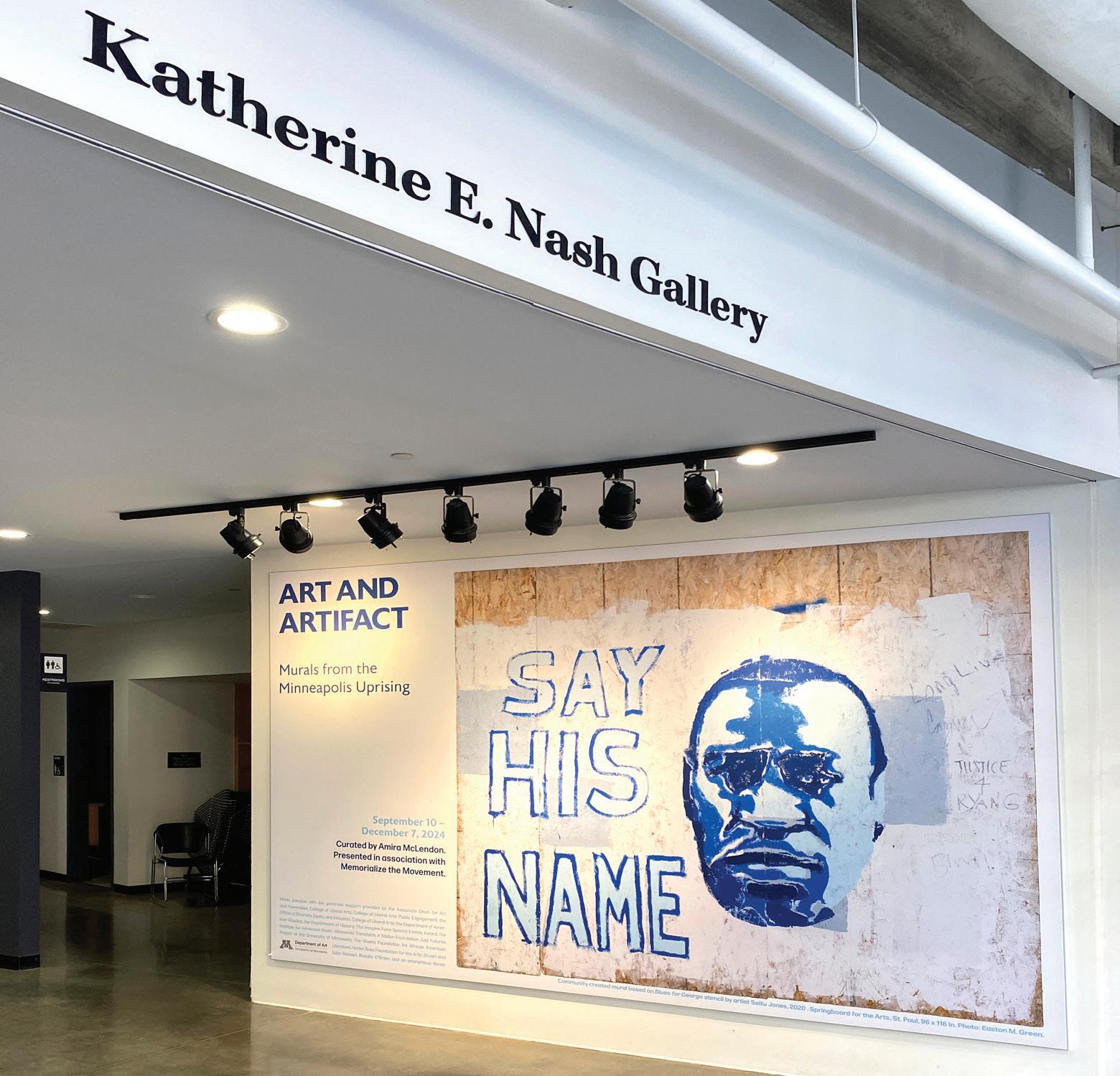
EPA mandates water companies nationwide dig up and replace lead pipes
By Jennifer Porter Gore
ead-contaminated
drinking water is a long-known health hazard that can cause developmental problems in children and health issues in adults. But many households still get their drinking water from utilities that use lead pipes — especially in Black communities.
A decade after the Flint, Michigan water crisis made national headlines, the Biden administration finalized a landmark rule this month requiring water utilities nationwide to locate and replace all lead pipes in their infrastructure systems by 2034. Speaking at a public works field office in Milwaukee, President Joe Biden called the new rule an overdue environmental justice win for underserved communities, which he said had “borne the brunt of lead poisoning for damn too long.”
The Lead and Copper Rule Improvements addresses what
is widely known as a major public health threat that is particularly dangerous to infants and children. Lead exposure in public drinking water is a longstanding issue that has disproportionately affected the nation’s Black communities for decades.
Neighborhoods prioritized Along with the new rule, the EPA announced $2.6 billion in newly available drinking water infrastructure funding through the Bipartisan Infrastructure Law. These funds will support lead pipe replacement and inventory projects, and 49% of the funding must go to disadvantaged communities as grants that do not need to be repaid.
The issue exploded 10 years ago when it was revealed that the entire population of Flint, a predominantly Black city, had been drinking water from the Flint River pumped through lead pipes. The scandal erupted when scores of residents complained that the

Speaking at a public works field office in Milwaukee, President Joe Biden called the new rule an overdue environmental justice win for underserved communities.
foul-smelling, discolored water was causing skin rashes, hair loss, and itchy skin.
The issue has still not been
‘Bringing Hope to the City’ Gala raises funds to end gun violence

By Cynthia Moothart Managing Editor
ommy McBrayer Jr. understands the impact of gun violence.
Home from college in 2010, he started selling marijuana to make money and get off friends’ floors and couches.
After a drug deal turned violent, McBrayer was tied up, shot, and left for dead.
“That was an eye-opener for me,” he says. “I knew I had to get on a different path.” McBrayer became a community organizer with CANDO, the Central Area Neighbor-
hood Development Organization, which seeks to build an urban landscape that heals, not harms, by eliminating systemic oppression. He also began hosting a Thanksgiving dinner, a free gathering in his apartment that grew into a significant community event held in public spaces. But even a turnaround in life didn’t protect McBrayer from gun violence. Almost a decade after that near-fatal drug deal, McBrayer was shot twice in the belly during an argument with an intoxicated family friend. The following year, a year in
fully resolved. Two years later, authorities found record levels of lead in the drinking water of
■ See WATER on page 5

By Alexzia Shobe Staff Writer
innesota is at a critical juncture of reconciliation.
In the wake of George Floyd’s murder on May 25, 2020, at the intersection of 38th Street and Chicago Avenue in Minneapolis, the area has been transformed by the community into a space offering solace from the pain of shared heartache.
Officially designated as George Perry Floyd Square, the intersection became a focal point for memorials, protests and dialogues surrounding systemic racism and police brutality. The city prepares to unveil its plans for redeveloping the square at a dinner dialog on Oct. 29.
Since March, the city has collaborated with the Black-led architectural design firm 4RM+ULA and the Cultural Wellness Center to conduct a series of dinner dialogues and visioning workshops to create a comprehensive blueprint for the square’s redesign.
ity, and respect for the social movements that emerged from this tragedy. The city’s engagement goals are multifaceted. They include allowing for racial healing, fostering community relationships, and ensuring that the redesign reflects the needs of local residents. Feedback gathered from community stakeholders noted the need for economic vitality, safety improvements, and spaces that encourage gathering and reflection.
As the city moves forward, key design principles have emerged, focusing on creating a sacred space. Notably, officials have stated that there will be no vehicular or transit access to the exact location where Floyd was murdered—reinforcing the square’s status as a memorial site.
“George Floyd Square is a place of profound significance for our city, and its development will reflect our commitment to community-led transformation.”
Public Works staff emphasized the importance of honoring the voices of Black, Indigenous, and People of Color (BIPOC) communities, stating, “This is a significant opportunity for us all to define the future of 38th & Chicago.”
Community engagement has been a cornerstone of this transformation, with many residents advocating for a redevelopment process that prioritizes healing, inclusiv-
“George Floyd Square has been a dynamic community memorial space since the day George Floyd was murdered,” said Alexander Kado, Minneapolis senior project manager. “Community members and local caretakers have been preserving the memorials by working with artists. Rise and Remember (formerly George Floyd Global Memorial) has led the preservation effort.”
In light of the city’s efforts to reimagine the square, questions remain about the path to repair and forgiveness. Historical precedents, such as memorials for victims of the Vietnam War, illustrate the importance of thoughtful design and community involvement in
■ See GFS on page 5
which Minneapolis registered 98 gun-related deaths, McBrayer founded Don’t Shoot Guns, Shoot Hoops (DSGSH)— a nonprofit committed to ending gun violence. Made up of
■ See GALA on page 5 Tommy McBrayer
Frey’s threatened budget cuts called
Mayor claims there’s no money to save homeless shelter
By JD Duggan
Contributing Writer
Mayor Jacob Frey’s office and city staff threatened cuts to a Northside park, work on non-police alternatives, racial equity audits, and informing employees about benefits enrollments after the city council approved a resolution allocating $1.5 million to keep a homeless shelter operational.
The council voted last month to give $1.5 million to Agate Housing + Services to make needed repairs for things like plumbing at its century-old 137-bed homeless shelter in downtown Minneapolis. This sparked an equal matching donation from an anonymous donor that filled the shelter’s financing gap. Less than a week after the vote, Mayor Jacob Frey’s office said the money doesn’t exist and threatened a series of cuts in response.
For perspective, the city’s 2024 budget is $1.8 billion; the Agate allocation represents .08% of that. Frey’s office and city staff say the council was not looking at the city’s budget holistically, pulling information from a quarterly budget projection.
That budget projection expects the city will end the year with a $38.5 million surplus, but doesn’t take into account an expected $36 million revenue shortfall. Council members noted the city ended each of the last six years with an average $21.7 million surplus, and the city has repeatedly been recognized for strong financial performance.
Frey wrote a letter to the
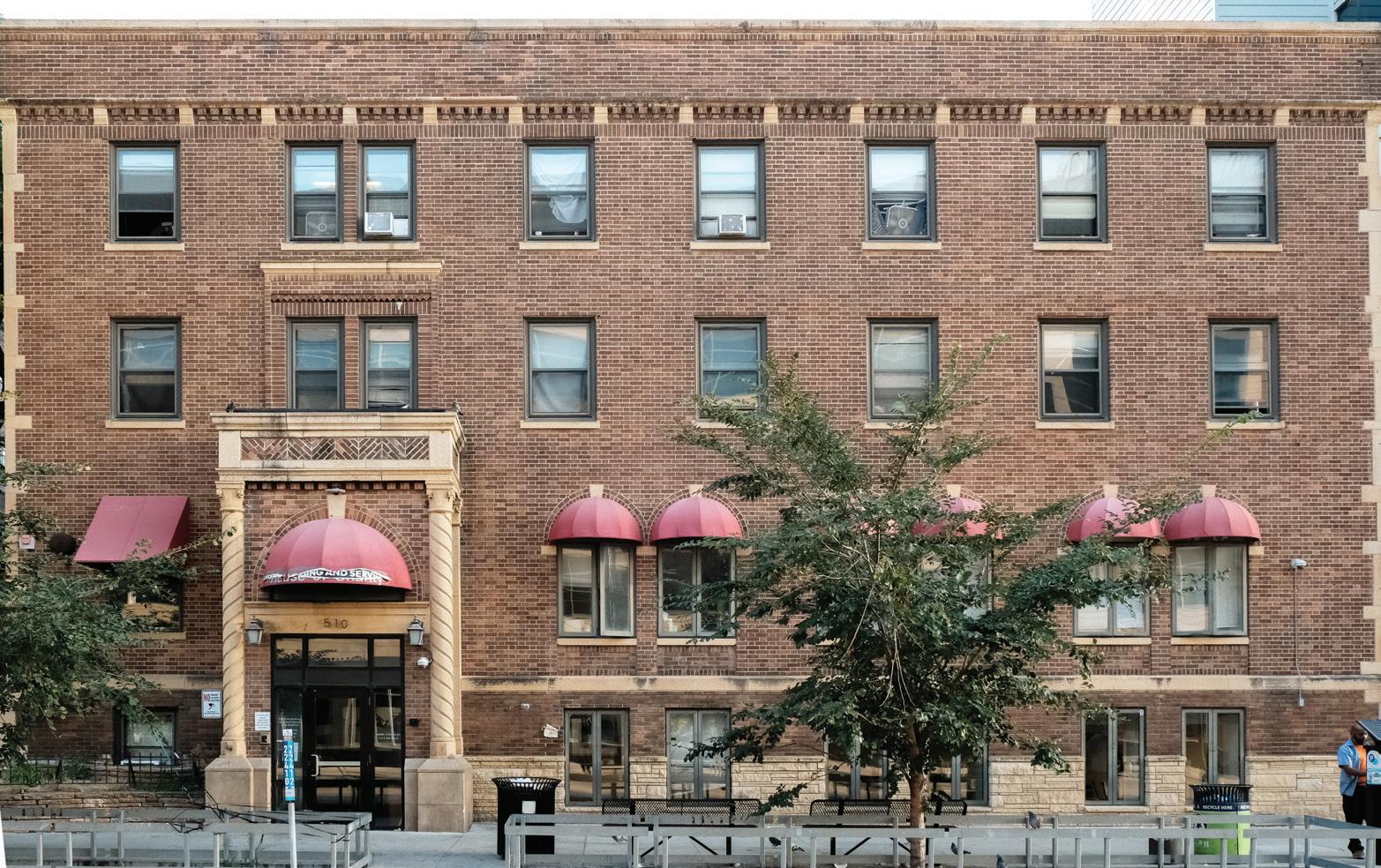
council Sep. 26 saying that unspent funds at the end of the year help reduce property taxes in future years, and the council’s action could increase the tax burden for residents in 2026.
“While the intent is commendable, this funding decision lacked proper vetting and was based on point-in-time budget projections, which is completely irresponsible,” Mayor Jacob Frey wrote to the council. “The $1.5 million you set aside is not free money, it must come from somewhere. Because of this council action, several city departments and services will be affected.”
He said they did not properly vet the proposal among the many subject experts on staff, and their decision did not create a competitive, fair process.
“What will you do when more local organizations and nonprofits need support? Will
you simply slash more city services?” Frey wrote. “To protect key investments and vital city resources, my administration will work through the regular budget amendment process to identify a less disruptive source of funding.”
“Now all of a sudden the sky is falling. That feels like political games to me.”
Garnett-Hochuli and Frey listed multiple budget cuts that will happen in response to the council’s decision:
North Commons Park, in Northside’s Willard-Hay neighborhood, will lose $350,000. “Your motion targeted the projected surplus,” Frey wrote in his letter. “North Commons is that ‘surplus.’” He
said the other option is to lay off city staff.
“Alternatives to Policy pilots” would lose $30,000. These programs happen under the Performance Management and Innovation department, which seeks alternatives to enforcement—whether that’s police or regulatory—and these pilots could be cut. PMI has led work on non-police alternatives, like behavioral crisis response efforts.
The Assessing Office, which classifies and values properties in the city, would not get “State required Continuing Education” for its staff under the threatened cuts.
If the cuts occur, the city would not tell its employees when benefits enrollment is open next year. Other cuts would hamstring the city’s recruitment efforts by ending its subscriptions to LinkedIn and
Indeed and ending participation in job fairs and recruiting events. Updates to the human resources website would also end.
The Racial Equity, Inclusion, and Belonging Department will also reduce its efforts to track racial equity standards
Multiple council members said that the cuts, which were publicized just days after the council’s resolution, are retaliatory.
Ward 5 Councilmember
Jeremiah Ellison said the Frey administration didn’t support the other funding options the council explored for Agate’s shelter, so the council took the latest action.
“As somebody who generally feels like we’re all up here operating in good faith, that feels like games to me,” Ellison said of Frey’s cuts at an Oct. 2 meeting. “Now all of a sudden the North Side is affected, and now all of a sudden the sky is
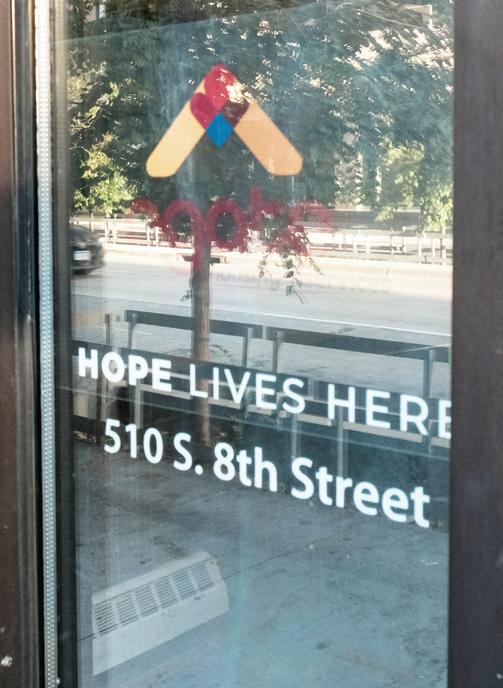
falling. That feels like political games to me.”
Ward 11 Councilmember Emily Koski said in an email that Frey’s proposed cut to North Commons Park is an example of the “Washington Monument ploy,” which is a tactic politicians use to avoid budget cuts by emphasizing the potential loss of popular projects.
“The goal is to make the actions seem more harmful than they are by threatening highly visible and valued things,” Koski wrote to the Spokesman-Recorder. “The goal is to trigger public opposition.”
The council voted on Oct. 2 to improve tracking of city funds as a response to Frey. Even Ward 3 Councilmember Michael Rainville, typically a Frey ally, supported that action, agreeing with Ellison that “more information is better.”
But, Rainville noted, “any surplus just goes to the bottom line for next year and helps us reduce the levy, reduce the taxes.”
Multiple council members said during the Oct. 2 meeting that homelessness is an emergency and the funding was necessary to respond to that emergency.
Koski said the city has “a cushion of reserves on top of our cushion of reserves.” She said the city’s financial situation is stable, and “we have the capacity to spend $1.5 million on an emergency without disrupting the budget.”
JD Duggan welcomes reader responses to jduggan@spokesman-recorder.com.

By Stacy M. Brown
As they gather at their morning “coffee spot” on thick pieces of cardboard placed strategically under a small concrete overpass adjacent to the Walter E. Washington Convention Center, three residents—Avery, Monique, and Justice—once epitomized the American Dream.
Avery drove a Porsche and shared a three-bedroom home with his girlfriend. Monique, a single professional working at a Fortune 500 company, coowned a condo with a childhood friend and drove a latemodel Nissan Rogue. Justice, a federal employee, shares twin daughters with his ex-wife.
Now, each faces a devastating battle with addiction, having lost their homes, careers, and family connections in the process. Their stories reflect the broader opioid crisis that continues to grip the nation.
Preliminary data from the Centers for Disease Control and Prevention (CDC) suggests that some inroads are being made. According to figures released this week, overdose deaths dropped by 10% in the 12 months ending in April 2024, with just over 100,000 fatalities. A significant portion of this decrease is due to a decline in opioid overdoses, which fell from their peak of more than 86,000 annual deaths last summer to an estimated 75,091 in the latest period.
Though the figures remain grim, they represent a slowdown after years of relentless increases. Even so, the situ-

ation is far from stable. The pace of opioid-related deaths remains significantly worse than before the pandemic when fatal overdoses numbered under 50,000 annually.
Fatalities from other drug groups, like cocaine and stimulants, are also trending down, but opioids continue to drive the bulk of overdose deaths. In several Northwestern states— including Alaska, Colorado, Nevada, Oregon, Washington and Wyoming—overdose rates remain near or above record highs. At last month’s debate, Democratic presidential nominee Kamala Harris pointed to
her work as a prosecutor and her role in the Biden administration’s bipartisan efforts to address the crisis. She mentioned how Republican nominee Donald Trump blocked a proposed immigration bill that would have helped stop the flow of fentanyl.
“I know there are so many families watching tonight who have been personally affected by the surge of fentanyl in our country,” Harris said as she highlighted the administration’s continued focus on curbing the epidemic.
Biden administration officials have credited various
measures, such as the FDA’s approval of over-the-counter sales of naloxone, the overdose-reversing nasal spray, for the reduction in deaths.
“Over the past four years, the administration has taken unprecedented action to tackle this crisis head-on, and today’s data shows the largest decrease in overdose deaths on record,” said Dr. Rahul Gupta, director of the White House Office of National Drug Control Policy, in a statement last month.
“Psychology Today” reports that more people who use drugs now carry naloxone,
which reverses opioid overdoses, and friends of drug abusers are often prepared to administer the life-saving drug. Treatment programs, including medication-assisted treatments like buprenorphine and methadone, have reduced risks for those in recovery.
Experts suggest that another factor in the declining death rates may be the toxic tranquilizer xylazine, which is sometimes mixed with fentanyl. While dangerous to users, xylazine can dilute fentanyl, potentially reducing its lethal impact.
The CDC’s provisional data reflects a complex and evolving crisis, with opioid overdose deaths dropping from 84,181 in 2022 to 81,083 in 2023. However, deaths linked to methamphetamine and cocaine rose during that period, underscoring the challenges of the drug epidemic.
“I’ve


Experts have warned that the United States, with nearly 100,000 overdose deaths annually, is uniquely vulnerable, as street drugs have become increasingly contaminated with fentanyl, methamphetamines, xylazine, and other
dangerous substances.
For Avery, Monique and Justice, these statistics resonate deeply. Avery, who has lost friends to overdoses, said he finds encouragement in the declining numbers.
“To hear that deaths, or just overdosing, is declining warms my heart,” he said, sipping on black coffee on a relatively cool mid-morning in front of the Washington Convention Center. “I guess for me, it’s just more hope that I can do it, too.” Monique, whom the trio agreed dubbed their current location the “coffee spot,” reflected on how far she has come from the throes of a $350-a-day heroin habit.
“I’ve seen people die right here on these mean streets. I don’t want to be one of them, and I am going to get my life back,” she said, with a determination that belies her struggles. Justice, who dreams of reuniting with his daughters, acknowledges the progress while yearning for a more definitive end to the crisis. “One of these days, maybe we won’t see anybody dying from this [junk].
“One of these days, people will look at people like me and understand it’s not worth it,” he continued. “Does it make me happy to hear you say overdoses are going down? No. It will make me happy when someone says overdoses don’t happen at all anymore and nobody is addicted to drugs anymore.”
This story first appeared on The Washington Informer website and is used with permission.
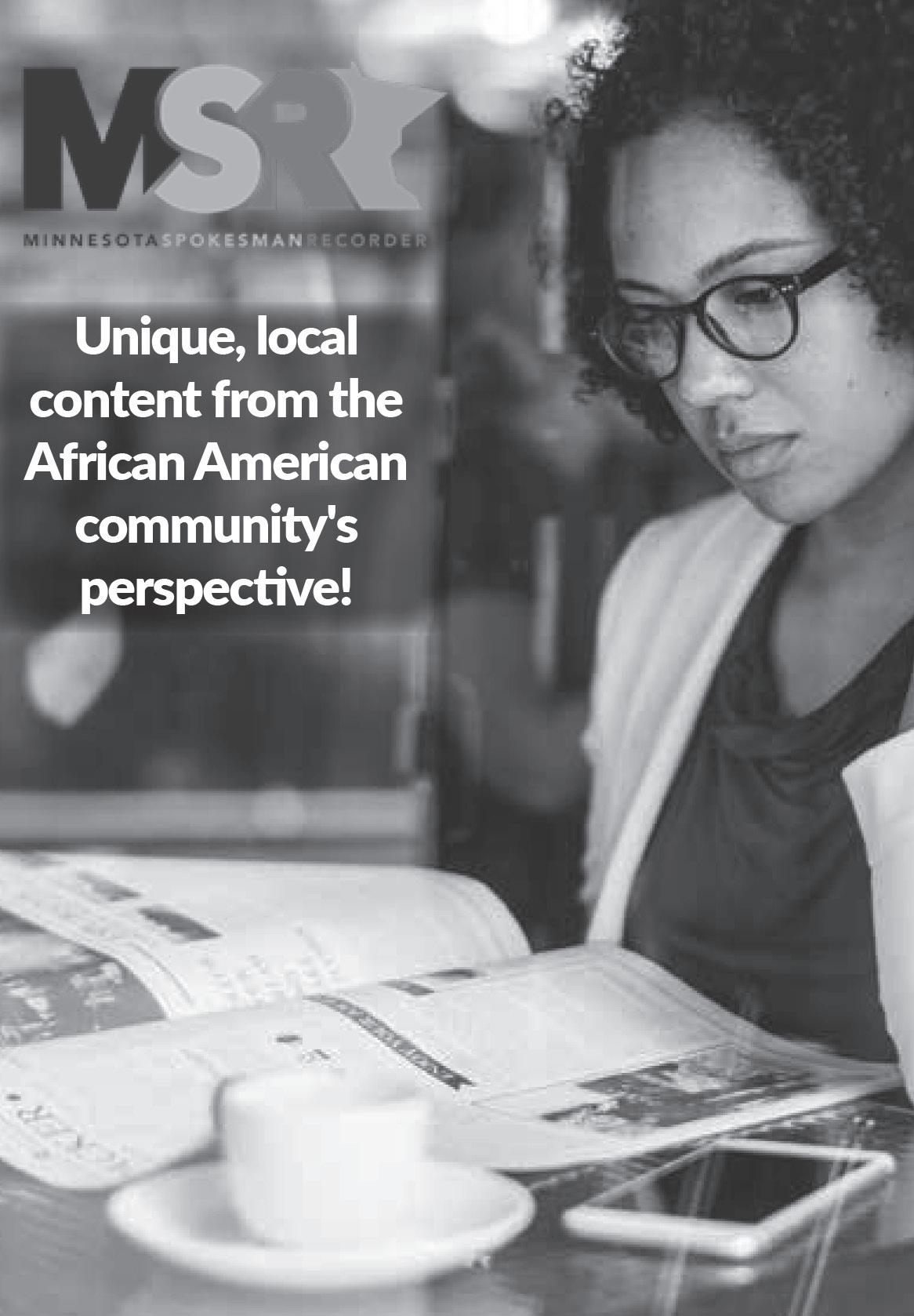



By Alexzia Shobe Staff Writer
In the bustling beauty scene, Monique Green has carved out her own path as the founder of Mullur’e Cosmetics. Since its launch in 2016, her brand has become synonymous with innovation and philanthropy, reflecting her morality and deeprooted passion for cosmetics.
She also created Mini Mullur’e in 2016 for her eightyear-old daughter. Green is setting up her child to be an entrepreneur at a young age and motivating her to be inventive and hard-working, principles that Green’s mother instilled in her.
Green was profoundly influenced by her mother, a woman with a keen eye for fashion who encouraged her love for creativity despite hesitancy to allow her young daughter to wear makeup.
“My mother would let me play in her clothes and always made me feel beautiful. She encouraged me to share that feeling,” Green recalls warmly. Intent on doing just that, she created Mullur’e Cosmetics to help women and young girls feel beautiful and confident. When Green faced the devastating loss of her mother to ovarian cancer in 2018, her heartbreak further fueled her determination. Her brand now reflects her journey and her commitment to a cause. A portion of the proceeds from her makeup line “Teal I’m Pretty” are donated to ovarian cancer research, ensuring her mother’s legacy continues to shine.
After watching countless YouTube tutorials to hone her skills, Green took a leap of faith and flew to Chicago for a two-hour makeup class in 2019 taught by one of
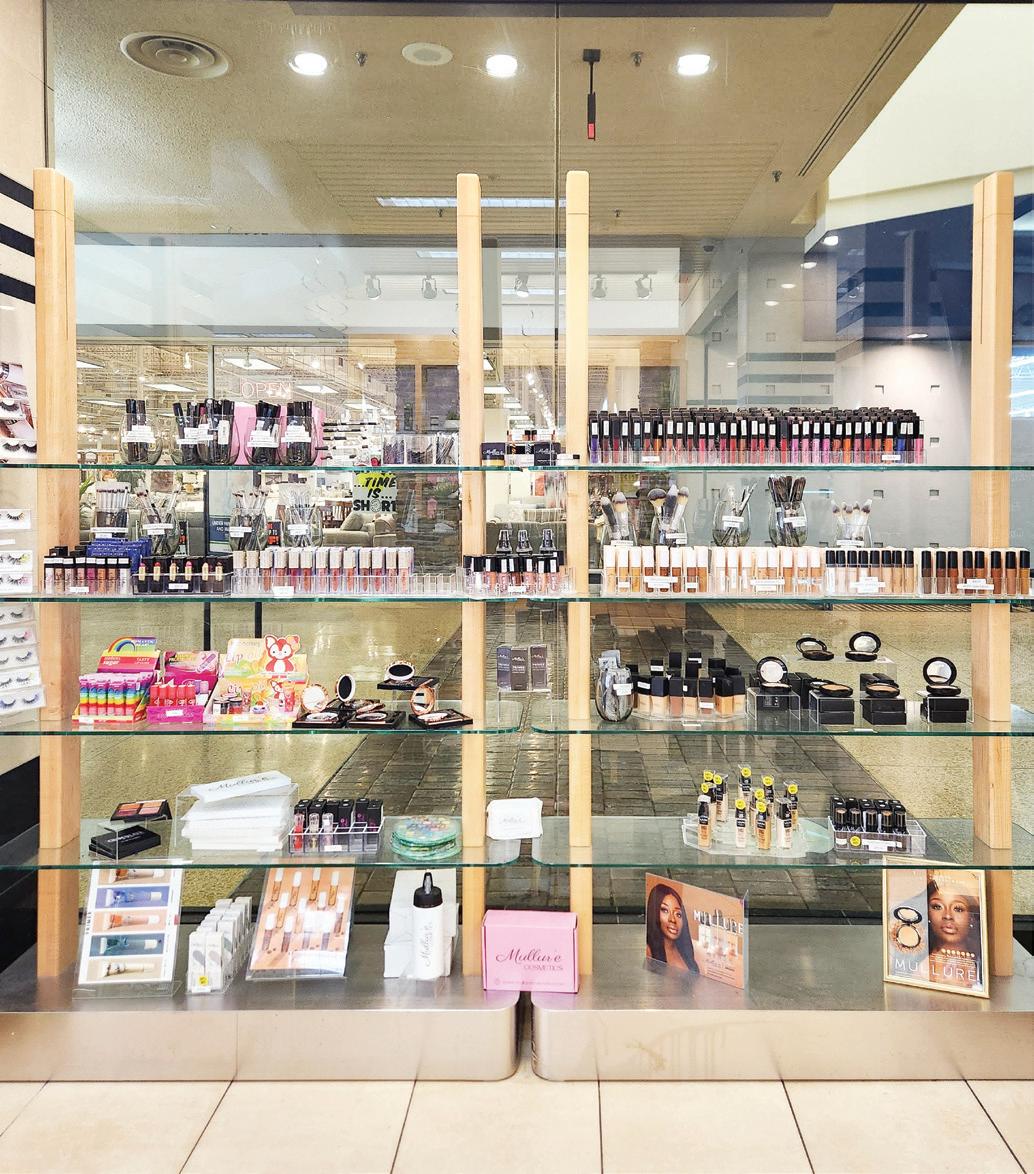

A cybersecurity breach can present significant threats to your business. No matter the size of your organization, it’s important to take cybersecurity seriously. Your data is your company’s most important asset, and you need to keep your digital operations safe. Most businesses also rely on external partners and vendors, which can introduce cybersecurity risks that must be carefully managed.
Whether you’re a seasoned business leader or just beginning to prioritize cybersecurity measures within your organization, it’s important to equip your company with the knowledge and tools necessary to enhance cyberreadiness. These tips and best practices may help protect your organization in an everevolving threat landscape.
1. Create guidelines to access your data Businesses should develop protocols for responsible use of technology resources within their organization. Users should only have access to the data they need to do their jobs, and should avoid accessing, sharing or disclosing
her favorite beauty influencers. This pivotal moment was more than just a class; it was a clarion call to keep chasing her dreams.
Following that trip, she began creating YouTube videos of her own and garnering a faithful audience. As her brand was taking off, she often did women’s makeup for free to practice her methods and record the services for content. She strategized her success every step of the way, but always at the forefront of her preparation was the mission her mother inspired.
Mullur’e Cosmetics is not just another beauty brand: It embodies a vision of inclusivity and empowerment. Greeh emphasizes the importance of providing women and young girls with a space where they feel gorgeous and self-assured.
“I want to serve every girl and help them highlight who they are,” she says. Green’s approach is refreshingly authentic, steering clear of commercial trends with no connection to herself and her clientele.
Inclusivity is woven into Mullur’e’s fabric. The brand boasts extensive foundation and concealer shades, ensuring everyone can find their perfect match. “Mullur’e Cosmetics celebrates diversity,” she says.
Despite the complexities of launching a cosmetics line, Green found strength in her community. “There wouldn’t be a Mullur’e if we weren’t part of the community,” she says. Engaging with her clients not just as customers but as partners in the creative process is vital to her approach.
“I listen and converse with them while providing services, which helps me understand their needs better.”
Her commitment extends beyond products. Green ac-
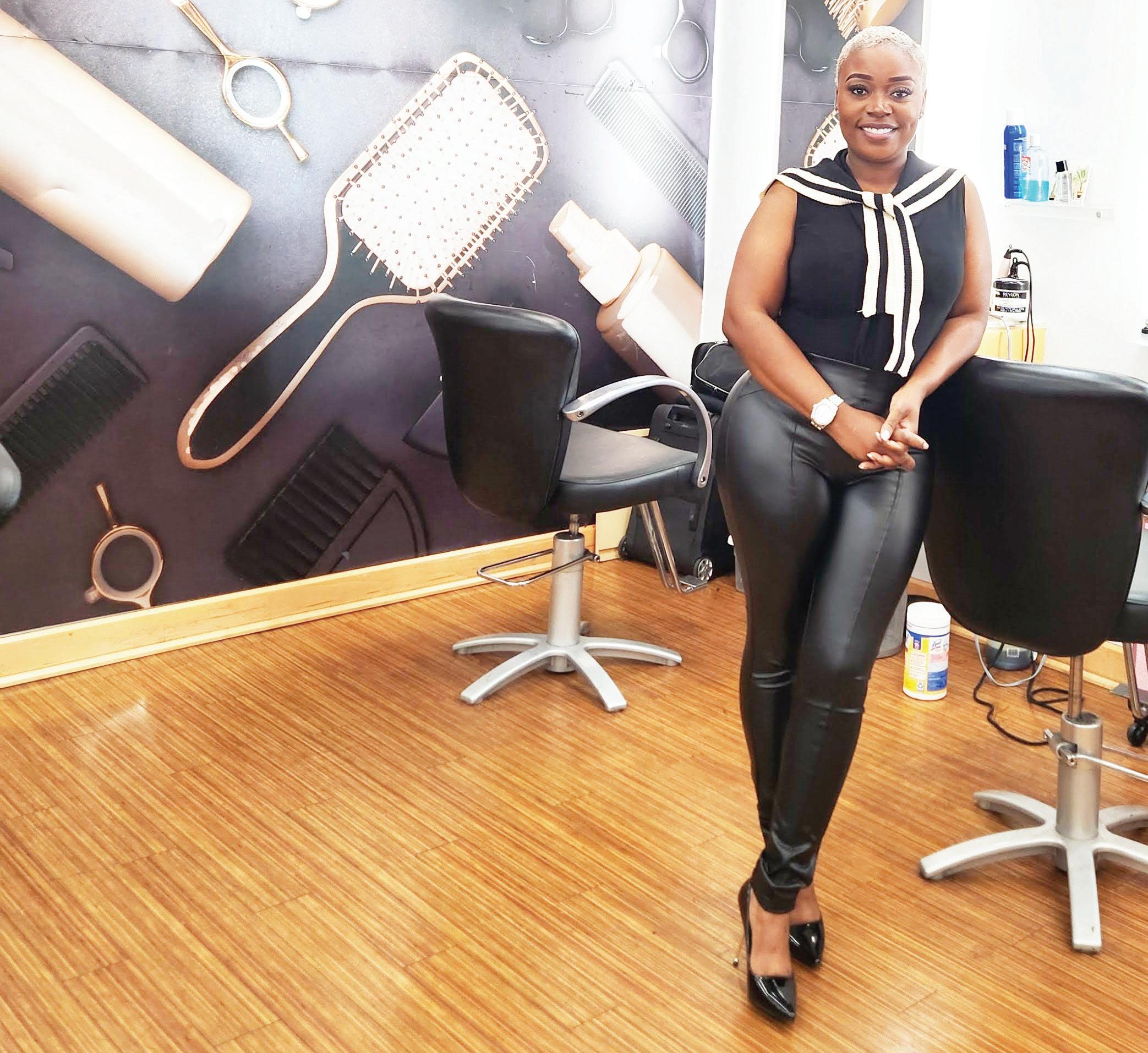
“The fulfillment I get from positively impacting people means the world to me.”
tively participates in community events and mentorship programs. Her efforts reflect a deep-seated belief in giving back, from raffles for students needing makeup services for special occasions, like Homecoming, to workshops teaching self-confidence and makeup skills at local schools. “The fulfillment I get from positively impacting people means the world to me,” she says.
Sustainability and inclusivity are priorities for her. Mullur’e products are crafted with natural ingredients that cater to sensitive skin. She’s leaning toward vegan-friendly formulations, as well. “I want everyone to be able to use my products,” she says.
Green observes a surge in opportunities for beauty entrepreneurs as the beauty industry evolves. “There are more resources, more influencers, and it’s a space where

sensitive information without proper authorization.
2. Keep an eye on your data Internal control best practices can include classifying data based on sensitivity (e.g., public, internal, confidential), regular auditing and monitoring, employee training, building an incident response plan, completing data backup and recovery, instituting thirdparty vendor assessments, making regular updates and disposal of data.
3. Manage your network Protect your network
across traditional data centers, your cloud or other vendor-hosted environments. A secure and well-managed network reduces the risk of cyber threats, enhances productivity, and contributes to customer trust and satisfaction. Require strong, unique passwords and multi-factor authentication for all network users, regularly update and patch systems and complete regular security audits and assessments.
4. Maintain business continuity Implement backup and disaster recovery plans to ensure
business continuity in case of a breach or cyberattack. Test data recovery procedures and processes, and develop robust incident response and business continuity plans to allow for swift recovery.
5. Protect your data with encryptions
Encryption can help protect data from unauthorized access in transit (when it’s being transmitted over networks) and at rest (when stored on servers or devices). This involves using technologies such as Transport Layer Security (TLS) and Secure
innovation can thrive,” she notes. With an eye on the future, she plans to expand her coaching business, Mode’le D’ Coaching, guiding aspiring business owners through the nuances of self-reflection and conviction in business. “You can’t have a successful business without knowing who you are.”
Green faced many challenges along the way, but she confided that her biggest challenge was uncertainty within herself. “I’ve never been the type to care what other people think. I’ve always been my own competitor,” she states. “Caring about other people clouds your mind and your judgment. I focus on God and myself and what we do for each other.”
Green is not just building a brand—she’s creating a movement. Mullur’e Cosmetics celebrates beauty, diversity
and empowerment, inviting everyone to embrace their unique selves. As Green puts it: “Follow your own path. Your path is unique, so get creative with it.” In doing so, she inspires countless others to do the same, proving that beauty is indeed more than skin deep; it’s about confidence, community, and the courage to shine.
Alexzia Shobe welcomes reader responses at ashobe@ spokesman-recorder.com.
Sockets Layer (SSL) to encrypt communications between servers, applications, users and systems. Ensure appropriate controls where encryption keys are stored, managed and accessed.
6. Create backup plans
Incident management helps to address and manage security incidents, breaches and other disruptive events that can impact your organization’s ability to deliver services and products effectively.
7. Identify vulnerable areas
Find security threats and vulnerabilities early to help reduce the risk of data breaches, financial losses, operational disruptions and customer dissatisfaction. Many industries have legal and regulatory requirements mandating incident response preparedness and reporting.
8. Ensure your business objectives are aligned
Outline goals and key performance indicators you want to align with your business objectives. Effective logging and monitoring help you maintain the reliability, security and performance of your services and products
9. Consistently log and monitor
Continue to observe your systems, applications and networks to ensure they operate efficiently, securely and reliably. Identify problems before they impact users, which allows for proactive resolution, reduced downtime and fewer service disruptions. Consistent logs also aid in investigating security incidents and ensuring compliance with data protection laws.
10. Test your applications in a separate environment
By developing and training your applications in a test environment, you can work out any bugs in a safe environment to help minimize security risks. Creating a secure and efficient work environment minimizes distractions and misuse of resources.
Stay Cybersafe Cybersecurity should be considered a top priority for your business. These cyber-safe steps are aimed to help small businesses address security gaps, to serve their clients and customers more securely. You can learn more about JPMorganChase’s Global Supplier Diversity pro
Continued from page 1
ensure that George Floyd’s memory and the circumstances surrounding his death are never forgotten.
Kelly emerged as a pioneering force in community-based art preservation through MTM, an organization born of divine intuition after she saw a black-and-white portrait of George Floyd with the words “I CAN’T BREATHE” written in red and white letters discarded behind a building.
“People always ask me what inspired me to create this organization, but it wasn’t a decision that I planned on making. It was a trauma response,” Kelly says. “In that moment, when I saw an image of George Floyd being discarded like trash, I was overwhelmed by the alignment with my ancestral trauma. My ancestors guided me into doing this work.”
Her experience resonates with broader themes of intergenerational impact and resilience. Just as the murals serve as a poignant reminder of collective struggles, research shows that trauma and stress can have profound effects that transcend generations, shaping the experiences and health of future descendants. This
Continued from page 1
healing spaces.
However, past failures in memorialization efforts serve as cautionary tales, emphasizing the need for genuine engagement with affected communities. Harriet F. Se-
Continued from page 1
schools in Newark, N.J.
Melissa Mays, operations manager of Flint Rising, a nonprofit advocacy organization, applauded the new rule in a statement for the National Resources Defense Council.
“Ten years ago, the drinking water in my hometown of Flint, Michigan was contaminated by lead because there were no strong state or federal laws and no enforcement to protect our water or our people,” she said.
“My community has pushed to reform the federal lead rule so the water crisis that damaged Flint would not happen to any
Continued from page 1
community members trained to interrupt cycles of retaliatory violence, DSGSH offers tools and strategies and connects high-risk youth and young adults to social services, gun violence survivors, and violence prevention programs.
“I was never around guns, was never gang-banging,” he says. “I was that funny kid. When I got shot again, it proved that it could happen to anybody. I don’t have a single friend who’s not been shot.
“In my neighborhood, we have more guns than people. We had to do something about it. We can’t wait for oppressors to come and fix our neighborhoods. We as a community have to do it.”
Statistics show that gun violence in Minnesota is a race-based epidemic. Black communities experience a gun homicide rate 21 times greater than that of white communi-
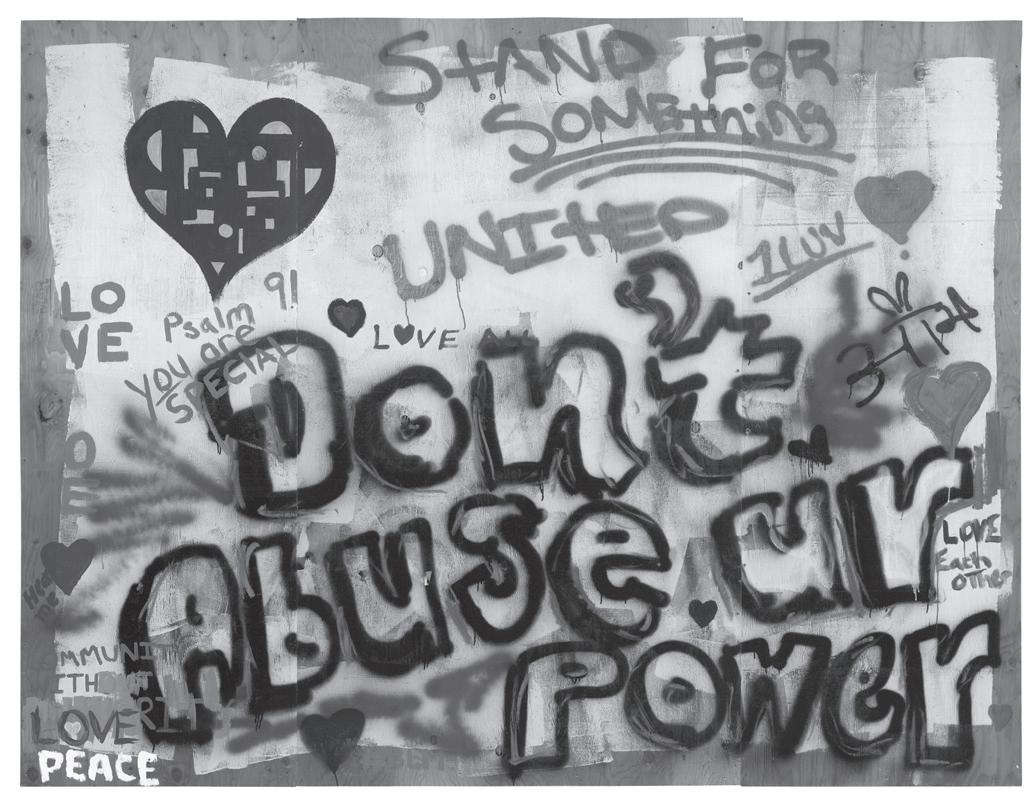
intergenerational transmission of trauma highlights the enduring legacy of systemic oppression, emphasizing the importance of community remembrance and healing as a pathway toward breaking cycles of suffering and fostering indomitability.
Motivated by the “why” rather than the “how,” Kelly set out to ensure that her community’s experiences weren’t erased from history. “What I saw when I looked at the murals was the full picture,” Kelly says, “each mural working alongside the others to tell a story of a people who refused to accept that another Black man had been murdered by the police.”
The goal of MTM and “Art
nie, professor emerita of art history at City College New York and a renowned expert on public art, is the author of several books and articles on memorials. In one essay she cautions, “[B]y focusing primarily on the victims, memorials to these events succeed in separating them from the event that caused their death.”
She believes that the con-
other city or town.
“Today’s announcement is not perfect,” Mays said, “but it’s a big step in the right direction.”
Long-known health hazard
EPA Administrator Michael S. Regan said in a prepared statement that Biden “is putting an end to this generational public health problem.
“We’ve known for decades that lead exposure has serious long-term impacts for children’s health,” he said. “And yet, millions of lead service lines are still delivering drinking water to homes.”
Lead is a neurotoxin that is dangerous in even the smallest quantities. The effects of lead
and Artifact” is twofold: to safeguard Minnesota’s Black community’s powerful narratives and to create a platform for these voices to be heard. Both aim to challenge the historical patterns of exclusion in the museum and art world, where Black and brown stories often are marginalized or misrepresented. In the U.S., data shows that 5% of all conservators, less than 7% of all historians, and only 4% of all curators are Black. Due to these disparities in the museum industry, representation is a crucial facet of Kelly’s work. She strives to set an example to inspire future generations of Black historians, preservationists and curators. Although the expedition has been arduous, she continues to tirelessly
flation of heroes and victims forms an assumptive basis of a memorial. “So, too, does the diversionary narrative of hope that emphasizes the triumphal communal spirit prompted by the respective heinous crimes, which projected war-like destruction into our civic midst.”
Activist leaders have said the community must determine what, beyond memori-
exposure are especially harmful to children younger than 6 years old and include irreversible brain and nervous system damage. Lead exposure also severely affects mental and physical development, learning and behavior problems, decreased attention span, and low academic achievement.
Physical harms from lead usually continue into adulthood and include kidney damage, digestive problems, high blood pressure, reproductive health issues, and attention deficit hyperactivity disorder. Adult exposure to lead is also harmful and long-lasting and can cause joint and muscle pain, high blood pressure, and hearing and vision damage.
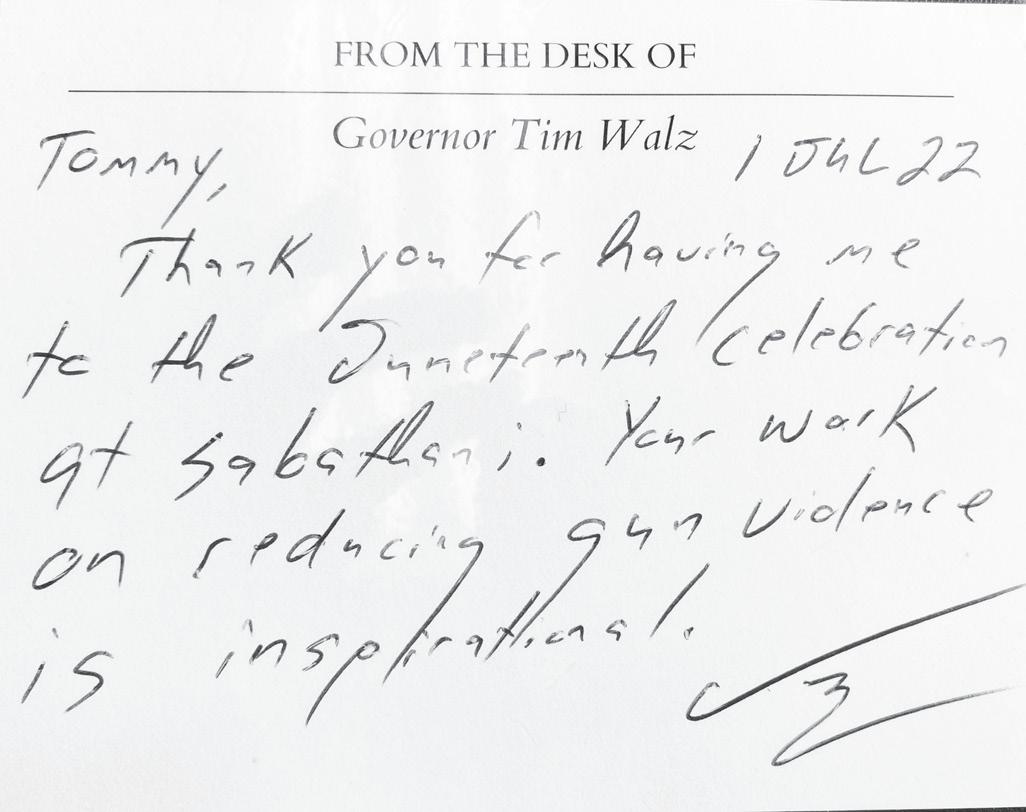
ties. Black youth living in Minnesota are five times more likely to die by firearm than their white counterparts. Overall, the rate of gun deaths in the state increased 44% from 2012 to 2021, compared to a 39% increase nationwide. During that same period, gun homicides increased by 171% in Minnesota, compared to a 73% increase nationwide. Between 2021 and 2023,
about 44% of state gun violence victims were Black, although Black people make up less than 8% of the overall population. During that same stretch, almost a quarter of gun victims were young people 18-24, although they account for less than 9% of the state population. In Minneapolis, the numbers are even more devastating. Last year, nearly 80% of
contribute to the fight against systemic oppression through philanthropy and artistry.
“While I know that there is still a long way to go, and I am just one of many people leading this work, I am proud to say that I can already see the buds of change peeking through the cracks,” she says.
Despite her relatively young age—23—McLendon has quickly become an outstanding presence in the art scene.
“When I was curating this exhibit, I wanted the entry to be striking,” she says. “It aims to simulate walking down the streets in Minneapolis in 2020 and seeing all of these murals up. I just really wanted to bring people back to what it was like to be here at that time.”
A memorial, by definition, is something that keeps remembrance alive. By that interpretation, their work is an active memorialization of the uprising. Memorials and art have always played crucial roles in societal healing.
In “Shadowed Ground: America’s Landscapes of Violence and Tragedy,” author Kenneth Foote explores three centuries of history—and how and why the sites of certain tragic and violent events are memorialized. Or not.
“Not only do [memorials] express in tangible form a community’s loss, but the very process
alizing this site, is needed for true healing to occur. They offer that this process requires a collective introspection that acknowledges the complexity of grief and the multifaceted nature of justice.
On this topic, Mayor Jacob Frey announced: “George Floyd Square is a place of profound significance for our city, and its development will reflect our
Service lines that bring water into homes have been found to be a major source of lead exposure. More than 9 million homes across the U.S. receive drinking water through a lead pipe, according to the EPA.
Scientific approach
“The Environmental Protection Agency followed a science-based process to set new limits under the Safe Drinking Water Act that will protect Americans—particularly children—from the harmful impacts of lead and copper on human health,” says Juliet Christian-Smith, Western states regional director at the Union of Concerned Scientists.
gun victims were Black; among juveniles, the number of Black victims jumped to almost 90%.
DSGSH will host a fundraising gala on Oct. 26 to support its work. The event, with the theme “Bringing Hope to the City,” will honor three community giants and feature musical performances by local artists. Joseph “Juice” Sutton—a comedian, actor, and in-game host for the Minnesota Twins and Minnesota Wild—will serve as emcee.
The goal is to have 400 diverse attendees, including community leaders, activists, lawmakers, and those passionate about stopping gun violence. The gala allows attendees to network, build relationships, and increase their visibility within these critical social circles.
“After George Floyd and the pandemic, the city hasn’t been the same,” McBrayer says. “But no matter what trauma we live through, we need to have hope,” referencing the gala’s theme. “I’m using my platform to bring hope by fighting the
through which they are created can help to heal wounds and resolve anguish in any stricken community,” he writes.
For centuries, public art has served as a canvas for collective memory and a means of processing trauma. It also serves as a catalyst for dialogue, pushing communities to confront uncomfortable truths.
In her essay, McLendon writes: “My hope is that you feel inspired by the strength and power of our community and feel driven to engage in dialogue and action. Pursuing justice is a collective effort that requires creative action.”
The work of Kelly and McLendon coincides with growing pressure on traditional museums to re-examine their practices and the narratives they uphold. By providing a platform for Black voices and stories, they challenge the museum industry’s colonial history and highlight representation’s importance.
As Kelly notes, “our existing in this space so successfully, with minimal resources and no formal education, is an act of rebellion against the system.”
“Art and Artifact: Murals from the Minneapolis Uprising” is more than an art book or an installation. It archives a collective stand against injustice and a stride toward revolution.
commitment to community-led transformation. Through ongoing engagement efforts, we’re ensuring the future of George Floyd Square reflects the values of those most deeply connected to the site—people are making their voices heard and we’re listening. We’re taking the time to get this right.”
As the city plans for the future, the ongoing dialogues
“In addition, the Bipartisan Infrastructure Law provides communities essential funding to replace old pipes that are the source of much of the lead in our water systems.”
In 2022, NRDC and its partners and 10 State Attorneys General sued EPA because of what it called inadequate rules the Trump administration had issued in 2020. The EPA agreed to scrap the previous rule and proposed these new lead standards in 2023.
“Lead-contaminated tap water has harmed the health and welfare of generations of our children. The EPA’s action today is a leap forward in protecting the health of tens of millions of Americans from
disease of gun violence.”
Cynthia Moothart welcomes reader responses to cmoothart@ spokesman-recorder.com.
Mosaic Venue (event space above Finnegans Brew Co.) 817 5th Ave. S 5-6:30
As the city finalizes plans for the development of George Floyd Square, solace can be found in Kelly’s preservation of this history. We stand together at the precipice of a grand opportunity for reconciliation. As Alice Walker noted, “healing begins where the wound was made.”
“ART AND ARTIFACT: MURALS FROM THE MINNEAPOLIS UPRISING”
The catalog is available for $29.99 at the University of Minnesota Press website: www.upress.umn. edu/9781517918989/ art-and-artifact/.
The exhibit runs through Dec. 7 at the Katherine E. Nash Gallery.
Hours: Tuesday-Saturday,
surrounding equity, justice and remembrance are set to shape the square’s redevelopment and the broader narrative of our public sphere. The final vision document and preferred street designs will be shared with the city council on Nov 12.
Alexzia Shobe welcomes reader responses at ashobe@ spokesman-recorder.com.
this scourge,” said Erik D. Olson, senior strategic director for health at NRDC. “It’s been 10 years since Flint’s water crisis jolted the nation into realizing that lead contamination is lurking in the tap water across America. It’s because of the tireless work of community leaders in Flint, Newark, and beyond that we got today’s strong standards.”
Vice President Kamala Harris, who is running for president this November, has also called for replacing lead pipes, an issue especially important for underserved communities.
Jennifer Porter Gore is a writer living in the Washington, D.C. area.
Ken Foxworth
Contributing Writer
As a college student in the early 2000s, Delphanie Daniels was tasked with a bold vision: Introduce step shows to the Upper Midwest. At the time, step shows were virtually unheard of in the Twin Cities, but Daniels’ determination and leadership transformed the landscape, creating a movement that resonated across the nation.
What began as a fundraiser for the ACE Institute of Learning mobilized the community, resulting in a widespread impact that continues today. The vision wasn’t just about entertain-
“It’s all about inspiring our youth to go to college and to join these types of organizations.”
ment; it was about connecting with the community and exposing youth to the positive outcomes of attending college and joining the Divine Nine, Black Greek-letter organizations.
With strong ties to the Divine Nine, Daniels offered valuable insights to the community, emphasizing that attending college was about academics—but also cultural enrichment and personal growth.
“We had all the talent here, but step shows were only happening in the South,” says Ray
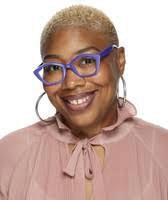
Seville, brought in to promote the original show. “It was Minnesota’s first step show and opened gateways for all the fraternities and sororities to get their shows together. It showed parents that their kids could perform on a national level and set up a whole other part of college life beyond academics.”
For more than two decades, people from around the Midwest reminisced about the impact of the original Midwest Greek Step Show. And over the years, Daniels was asked when she would bring back the iconic event.
That time has finally come.
Doors will open on “The Return: 2024 Midwest Greek Step Show” at Northrop Auditorium on Oct. 24.
With the support of Steve Davis, senior director of affinity engagement at the University of Minnesota Alumni Association, Daniels worked tirelessly to revive this cherished tradition.
“One of the reasons it has taken so long to relaunch is because we have been working behind the scenes to create a
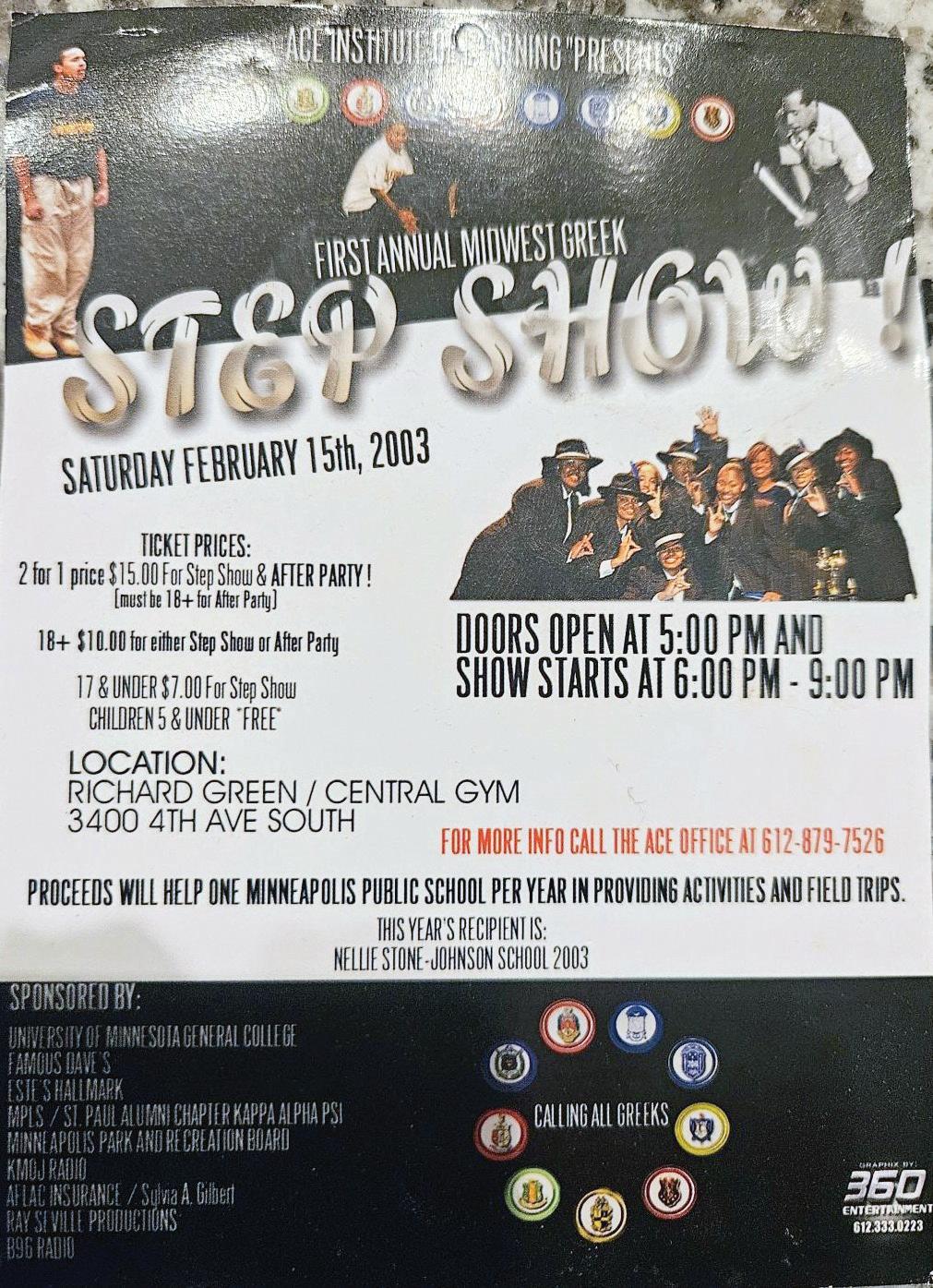
sustainable model to keep this event going at the University of Minnesota and make it a part of the Homecoming festivities with university support,” Davis says.
“I’m super proud that we have secured that, and after a major turnout at the step show from the community this year, we will make a statement as to why it is important to elevate this event every year at the University of Minnesota.”
Daniels, community engagement director of Best Buy, is thrilled to see the Midwest Greek Step Show return, offering a platform that highlights the achievements and potential of the Black community.
“I had no idea what the impact would be,” she says. “I am so deeply honored the community requested that the step show return. It’s an event that genuinely celebrates the culture of the Divine Nine and shows youth a path forward that they may not know. You can matriculate, go to college. It’s all about inspiring our youth to go to college and to join these types of organizations.”
This event reminds students and young people that success doesn’t come only through paths like music or sports. Doctors, lawyers, educators and lawmakers are represented in these Divine Nine organizations—all finding success and giving back to their communities.
The Midwest Greek Step Show is more than a competition; it is a celebration of resilience, culture, and the power of community. It offers a chance to witness the pride of organizations like Alpha Phi Alpha Fraternity, Kappa Alpha Psi Fraternity, Omega Psi Phi Fraternity, Phi Beta Sigma Fraternity, Iota Phi Theta Fraternity, Alpha Kappa Alpha Sorority, Delta Sigma Theta Sorority, Zeta Phi Beta Sorority, and Sigma Gamma Rho Sorority.
This event is the place for those who want to see these fraternities and sororities in action and experience the spirit and unity of the community. It’s a powerful reminder of the strength and vitality of the African American community, enjoying fellowship and sharing their rich heritage with the University of Minnesota and beyond.
“For the Black community specifically, it adds visibility to a presence that has been lacking for quite some time,” Davis says. “This is an opportunity to honor the rich history, tradition, and unity of these iconic Black Greek organizations and celebrate culture.”

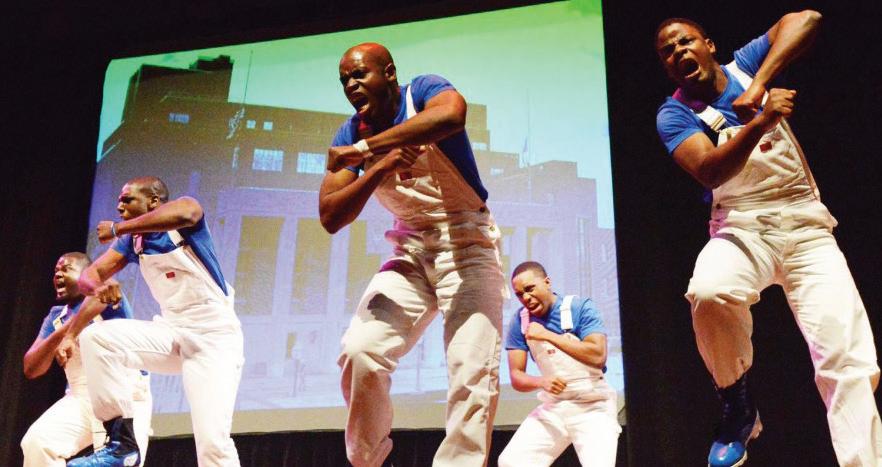
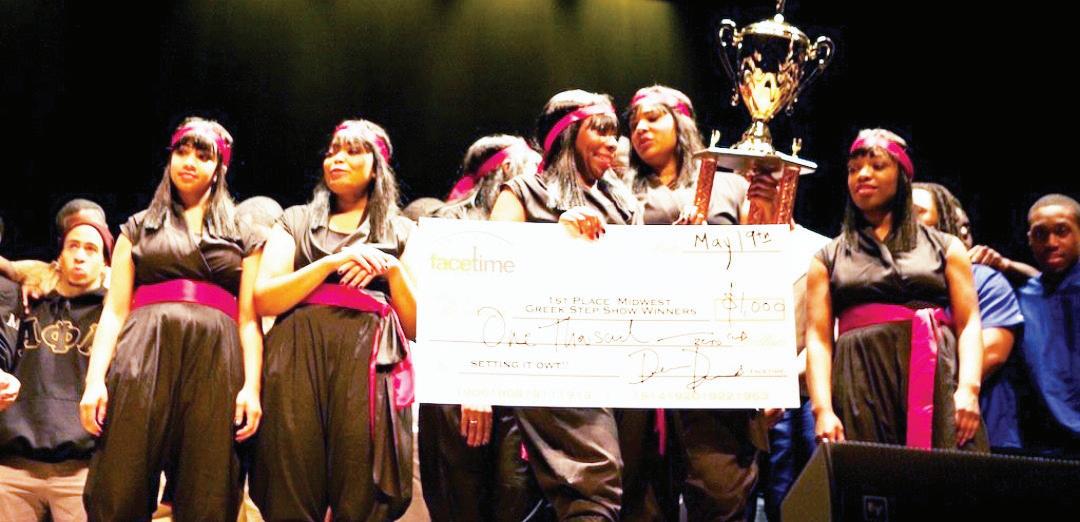
This year’s event is sponsored by FaceTime, the University of Minnesota Office for Student Affairs, the Office for Fraternity and Sorority Life, and the University of Minnesota Black Alumni Network. It is part of the University’s Homecoming celebrations and is free for UMN students. Tickets are $25 for community members.
Ken Foxworth welcomes reader responses to kfoxworth@ spokesman-recorder.com.


By NNPA News Wire
Civil rights icon and Na-
tional Newspaper Publishers
Association (NNPA) President and CEO Dr. Benjamin Chavis Jr. and NNPA Senior National Correspondent Stacy M. Brown collaborated on the groundbreaking book “The Transatlantic Slave Trade: Overcoming the 500-Year Legacy,” available now from Select Books. The work explores the brutal legacy of the transatlantic slave trade and its ongoing impact on African people throughout the world.
This searing book offers an unflinching account of the 500-year legacy of the transatlantic slave trade, beginning in 1500 with the abduction of millions of Africans and following the historical arc through centuries of oppression, Jim Crow-era terror, and modern systemic racism.
equality. Chavis, a central figure in the Civil Rights Movement, draws on his decades of activism and personal experiences in the fight for equal justice. As a young activist with the Southern Christian Leadership Conference (SCLC), he worked under Dr. Martin Luther King Jr. and later became a prominent leader within the United Church of Christ Commission for Racial Justice, the National Association for the Advancement of Colored People (NAACP), and the NNPA.
His wrongful imprisonment as the leader of the Wilmington Ten in 1971—a group of political prisoners falsely convicted and imprisoned for untruthful allegations of arson during the Civil Rights Movement in North Carolina— serves as a vivid reminder of the institutionalization of racial discrimination in America
“The chains of slavery may have been broken, but the shackles of systemic racism are still very much intact. If you’re not angry, you’re not paying attention.”
The book is an unapologetic examination of how the horrors of the past—rooted in slavery—continue to manifest in present-day America through police brutality, mass incarceration, economic disparities, and educational in-
that continues to suppress the human rights of communities of color.
“This book does not simply chronicle history; it challenges readers to face the lasting consequences of the transatlantic slave trade,” Chavis says.
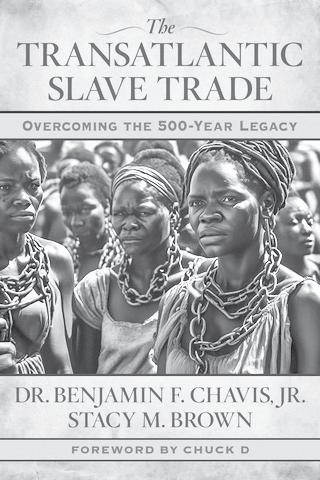
“The Transatlantic Slave Trade” is an unapologetic examination of how the horrors of the past continue to manifest in the present day.
“The blood, sweat and tears of enslaved Africans laid the very foundation for the American experiment in democracy, yet their descendants are still fighting for equality and justice in every facet of American life.”
Arikana Chihombori-Quao, African Union Ambassador to the United States, underscores the importance of the
book’s message. “Dr. Chavis connects the dots from the slave ports of West Africa to the present-day struggles of Black Americans.
“The transatlantic slave trade was not just a historical event—it laid the groundwork for centuries of racial oppression. The fight against that legacy is still ongoing.”
“The Transatlantic Slave
Trade: Overcoming the 500Year Legacy” digs deep into the trauma of the Middle Passage, where millions of Africans were stripped of their dignity, crammed into ships like cargo, and forced into lives of unimaginable brutality. The authors draw powerful connections between these historical atrocities and modern-day issues such as redlining, environmental racism, economic injustice and mass incarceration.
The book pulls no punches in confronting America’s hypocrisy: While African slaves built the economic foundation of the nation, their descendants are still treated as second-class citizens. From the auction blocks of the 1700s to the prison industrial complex of the 21st century, “The Transatlantic Slave Trade” unveils the continued systemic structures designed to oppress Black communities.
As legendary hip hop icon Chuck D of Public Enemy states in the foreword, “The chains of slavery may have been broken, but the shackles of systemic racism are still very much intact. If you’re not angry, you’re not paying attention.”
Chuck D’s call to action resonates throughout the book, echoing the urgent need to confront this history and dismantle the systems of oppression that have evolved from it. Public Enemy’s track “Can’t Truss It” is a thematic thread in the book, with its unfiltered depiction of the slave trade’s legacy.
The song’s haunting lyrics— “Ninety damn days on a slave ship / Count ’em fallin’ off two, three, four hun’ed at a time”—capture the rage and pain of an entire people. This visceral connection to history makes “The Transatlantic Slave Trade” a powerful rallying cry for justice and equity.
Brown brings keen insight into this exploration of history. He has relentlessly advocated for justice and equity, using the NNPA platform to shed light on systemic injustices nationwide.
In “The Transatlantic Slave Trade,” Chavis and Brown challenge readers to reckon with the uncomfortable truths of America’s past—and to acknowledge how those truths continue to shape the realities of today.
The authors highlight how the scars of slavery persist in police violence, economic disparity and the underfunding of Black communities. They demand that we face this history head-on without sugarcoating or sanitizing the truth.
“The Transatlantic Slave Trade” is a potent weapon in the ongoing battle for racial equity and justice, reminding us that the struggle continues—and so, too, must our resistance. The book is available at major book retailers and online platforms. The MSR will review the book further in a later issue.
By Laura Onyeneho
Bryant Reginald Moss (best known as Preacher Moss) has made a name for himself in the comedy world with his thoughtful and socially conscious humor.
Nicknamed “Preacher” as a child for his entertaining imitations of church pastors, Moss has always had a talent for engaging audiences. Raised in a Maryland suburb and in a predominantly African American community, his educator parents, instilled in him a love for learning and a deep sense of social responsibility.
“My mother and father always emphasized the importance of understanding our history and using our talents to uplift our community,” Moss says. This foundation would later become a cornerstone of his comedic and activist pursuits.
Moss’ journey into comedy was marked by a desire to address serious social issues through humor. He began performing stand-up in the late 1980s when comedy clubs were booming across the United States. His early material often touched on race relations, cultural identity, and social justice—topics close to his heart.
“Comedy was a way for me to talk about the things that mattered to me in a way that
people could relate to and understand,” Moss explains. His unique blend of humor and social commentary quickly garnered attention, and he found himself working with legendary comedians such as George Lopez, Dave Chappelle, and Damon Wayans.
A significant turning point in Moss’s life came when he embraced Islam in the early 1990s. He says this decision was deeply personal and transformative. “Islam provided me with a sense of peace and purpose that I had been searching for.” He grew up around the Nation of Islam and was inspired by Muhammed Ali and Malcolm X, both Black icons who transitioned into Islam. His faith profoundly influ-
challenging stereotypes and promoting interfaith dialogue.
In 2003, Moss co-founded the “Allah Made Me Funny” comedy tour, a groundbreaking project that highlighted Muslim comedians and addressed misconceptions about Islam. The tour was a resounding success, traveling across the United States and internationally and receiving acclaim for its bold and insightful content.
“The goal was to create a platform where Muslim comedians could share their experiences and perspectives,” Moss says. “We wanted to show that humor is a universal language that can bridge divides and unite people.”
Beyond comedy, Moss is a
“My mother and father always emphasized the importance of understanding our history and using our talents to uplift our community.”
enced his comedy, bringing a new layer of depth and introspection to his work. He began incorporating themes of spirituality, tolerance, and understanding into his routines,
dedicated activist and advocate for social justice. He has been involved in numerous initiatives to promote civil rights, interfaith understanding, and community empowerment.
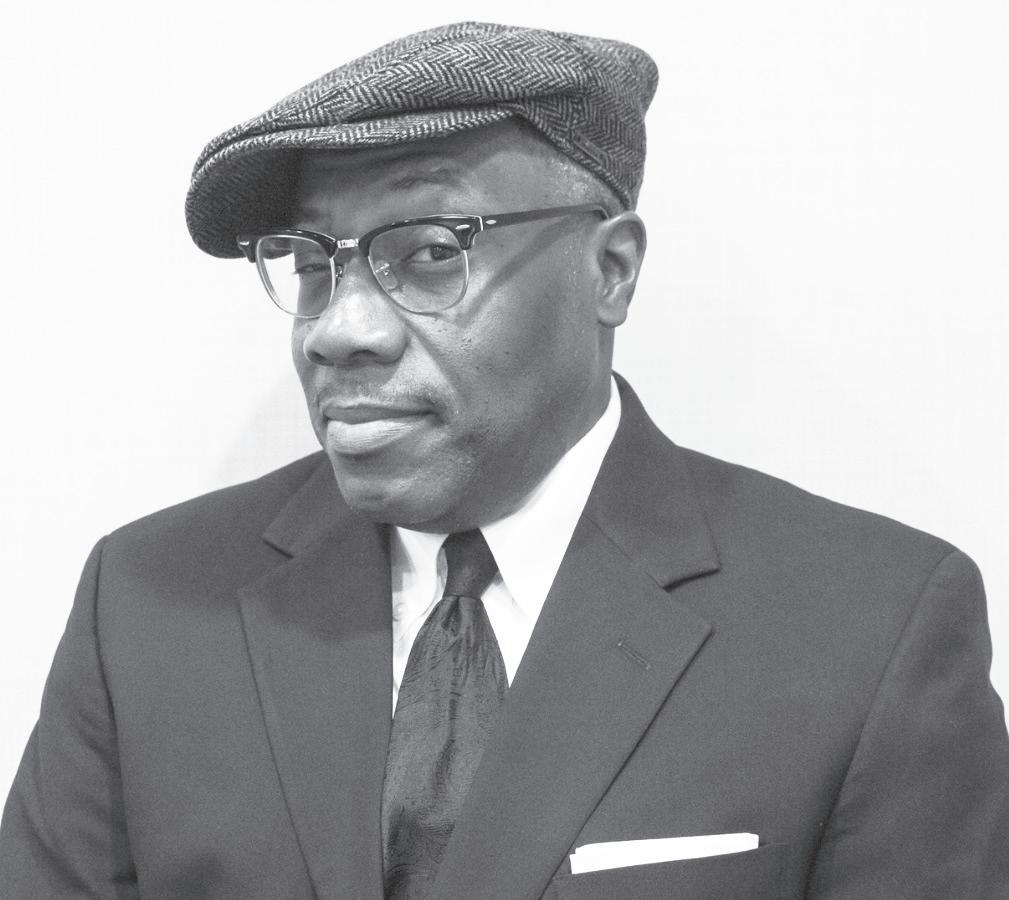
One of Moss’s most impactful projects is his work with educational programs in underprivileged communities.
He frequently visits schools and community centers, delivering motivational talks and workshops to empower young people and encourage them to pursue their dreams.
“Education is the key to
breaking the cycle of poverty and oppression,” Moss asserts.
“I want to use my platform to inspire the next generation of leaders and change-makers.”
Although Moss believes that the future of comedy is “cookie cutter” and “oversaturated,” he still has hope that comedy and activism will be important for change. “I believe that humor can be a powerful tool for healing and transformation,” Moss reflects. “In a world that often feels divided, we need more opportunities to come together, laugh, and recognize our shared humanity.”
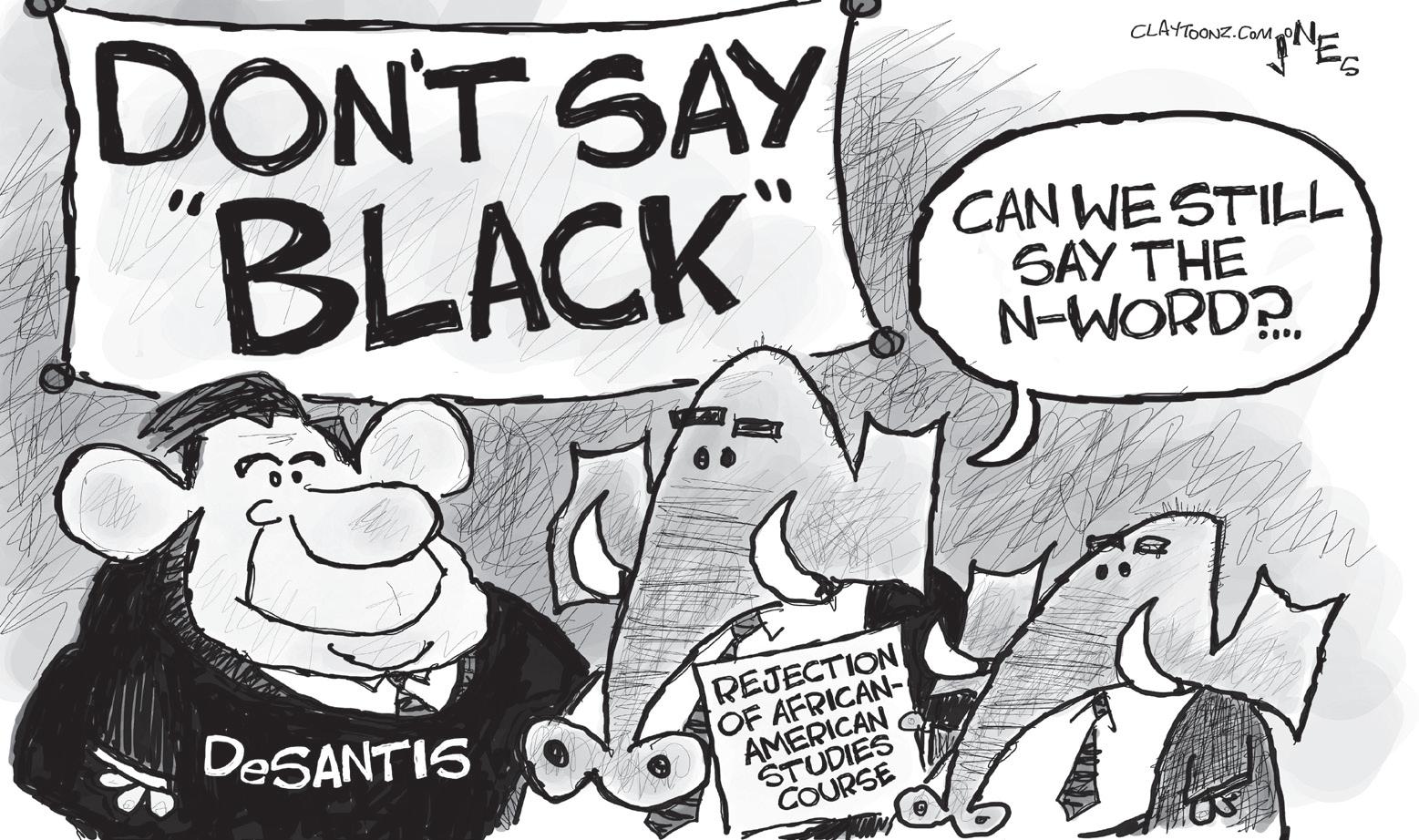
By Nicholas Glover
We are in a record-breaking moment for clean energy: Companies are investing in clean energy at levels never seen before, and more wind and solar projects are being built in the United States than ever before. And it’s just getting started.
This progress, which has been fueled by federal investments signed into law by the Biden administration, is not only reshaping our energy system to tackle climate change; it’s also reshaping the economic opportunities that can drive prosperity and wealth in communities around the country. I’m talking about new, high-paying jobs building clean technologies that can sustain families, training and apprenticeship programs that can launch young people’s careers in this fast-growing field, and the revenue that clean energy projects can pour into schools and roads.
These are unprecedented opportunities that can lift up workers, families, and entire communities, and we need to make sure they reach everyone—especially Black communities and communities of color that have faced a legacy of disinvestment and have been most harmed by polluting industries. While everyone has a role to play in this moment, mayors and community leaders are in a critical position to bring these communities to the forefront of new clean economic opportunities.
The two laws that have sparked many of the clean energy investments occurring now—the Bipartisan Infrastructure Law and Inflation Reduction Act—require that 40% of the overall benefits of these investments flow to disadvantaged communities. This
helps set a more level and equitable playing field for funding and incentives, but local leadership still matters.
Mayors and community leaders know the stories of their cities, uniquely positioned to understand local needs and challenges and how securing federal grants or clean energy projects can address them. Examples in Long Beach, California, and Detroit offer models for how to embrace clean energy and equity together.
In Long Beach, Mayor Rex Richardson is pursuing a longterm strategy that marries climate and economic progress with equity as “a guiding value.” That strategy is paying off as Ford announced this past June that it would develop its next generation of small, affordable EVs in Long Beach, creating nearly 500 manufacturing jobs.
environmental remediation, weatherization, and solar installation work. Trainees have gone on to work for the city of Detroit, the state of Michigan, and the private sector.
Now Detroit is partnering with Green Door to build solar farms in underserved neighborhoods.
The opportunities extend well beyond jobs and training too.
Mayor Richardson is demonstrating how to meaningfully drive new investment into communities that have been left behind.
West Long Beach is a vibrant area home to historic Latino, Black, Asian American and Pacific Islander communities; it’s also an area of the city that has been on the frontlines of climate disasters and has endured the majority of the city’s pollution, experiencing some of the worst air quality in the nation due to its proximity
Black workers comprise just 8% of the overall clean energy workforce.
To ensure that communities historically left out are meaningfully included, Long Beach is developing an Economic Inclusion Action Plan with local partners to better connect diverse communities with new clean energy jobs like these.
Local training programs are also critical to preparing underrepresented workers for new clean energy jobs, where diversity is alarmingly low. Black workers comprise just 8% of the overall clean energy workforce.
In Detroit, the Green Door Initiative, a local nonprofit, is demonstrating how to address this gap head-on. It trains communities of color and other underrepresented groups, such as returning citizens, for construction-related jobs in

VP Harris wants to help Black men build wealth, provide for our families, and lead our communities. Trump wants to use us as political pawns.
By Keith Boykin
Kamala Harris recently unveiled a new agenda for Black men. The plan is extensive, but I want to highlight 10 specific steps she would take as president that would empower Black men with the tools we need to build wealth, provide for our families, and lead our communities.
1. Business loans
Black Americans are twice as likely to be denied credit by banks, so Harris would provide one million fully forgivable loans of up to $20,000 to Black entrepreneurs and others who have historically faced barriers to starting a new business or growing an existing one.
2. More jobs without college degrees
Harris would eliminate unnecessary degree requirements and promote pathways for those without college degrees for 500,000 federal jobs.
3. More Black male teachers
As a former high school English and social studies teacher, I know it’s important for young Black males to see Black men in front of the classroom as role models and mentors. Only 1% of public school teachers are Black men, so Harris would create pathways for more Black men to become teachers, including apprenticeship programs and loan forgiveness.
cell disease, died last year, and I know several Black men my age who have been recently diagnosed with prostate cancer. And don’t get me started on the mental health needs of the Black men in my family and community. I see it every day. We’ve been traumatized by an unfair criminal justice system and a world that demonizes us instead of understanding us. Fortunately, Harris would launch a National Health Equity Initiative focused on Black men that addresses sickle cell disease, diabetes, mental health, and prostate cancer.
5. Weed equity Black men have been disproportionately arrested and incarcerated for marijuanarelated charges. Now that cannabis is becoming more socially acceptable and profitable, it’s only fair that we benefit from the changing system that hurt us. Vice President Harris not only wants to legalize recreational marijuana but also create opportunities for Black Americans to succeed in this new industry.
6. Ban the Box
I have a law degree, and yet when I lived in Harlem, I was still stopped on the street, arrested, and locked up in jail. I know Black men have been targeted by a racist criminal justice system. Harris would work with Congress to require businesses to limit the unnecessary use of criminal arrest histories, convictions, and credit scores in employment decisions.
7. Mentorship programs
Black men succeed. She will also support programs like My Brother’s Keeper.
8. Support Black farmers
Harris would continue to support Black farmers and ranchers who have been denied access to capital. As vice president, she already distributed funding to thousands of Black farmers and ranchers in a $2 billion relief package.
9. Relieve medical debt My stepfather passed away in April 2020 with a mountain of medical debt. Vice President Harris plans to work with states to relieve medical debt, which is the leading cause of bankruptcy in America and disproportionately hurts Black Americans.
10. Crypto protection
More than 20% of Black Americans, including me, have owned cryptocurrency assets. I lost money in crypto, but the high-risk, high-reward crypto markets provide opportunities outside of the existing stock market for many Black men. A Harris administration would support a regulatory framework for cryptocurrency and other digital assets to protect Black men who invest in these assets.
Kamala Harris wants to help Black men build wealth, provide for our families, and lead our communities. Trump wants to use us as political pawns in his angry MAGA campaign. Those are the choices. Choose wisely.
submissions@spokesman-recorder.com submissions@spokesman-recorder.com
submissions@spokesman-recorder.com.
to the 710 freeway.
Long Beach’s new Westside Promise, a 10-year investment strategy, is designed to direct public and private funding toward boosting economic development, improving public health and enhancing climate resiliency in West Long Beach, ultimately helping these communities reach their fullest potential.
These are just a few examples of how local leaders position their communities for success in the clean energy transition. A toolkit developed by Elemental Impact, the African American Mayors Association, and the Environmental Defense Fund offers more real-world examples and strategies on how to harness the array of investments out there. It’s a great place for local officials and community leaders to start.
And even for those who are not involved in local government or community initiatives, you hold more power than you may realize. The leaders we choose now are of profound importance if we are to continue making progress. Remember that when you vote.
It’s clear that we are in a profound moment of economic transition, one that is generating new pathways to wealth and prosperity. What’s less clear is who will benefit the most. We need mayors, local officials and community leaders to get in the game, embrace the job and investment opportunities at hand, and leverage them to bring communities that have been excluded in the past to the front and center of the clean energy revolution.
As a member of the Environmental Defense Fund’s U.S. Leadership Team, Nicholas Glover is vice president of the organization’s Build to Zero workstream.
4. Health care
My uncle, who had sickle
Harris would expand funding for community mentorship programs with a proven track record of helping young
Keith Boykin is a New York Times bestselling author, TV and film producer, and former CNN political commentator.
Dr. King and the power of the right to vote
By Dr. John E. Warren
On May 17, 1957, the third anniversary of Brown v. Board of Education, Dr. Martin Luther King Jr. and other prominent civil rights leaders convened the Prayer Pilgrimage for Freedom—a gathering of 20,000 at the Lincoln Memorial to urge the federal government to uphold the promises inherent in that Supreme Court decision.
The gathering predated passage of the Voting Rights Act of 1965 by eight years, yet Dr. King used his time to manifest the power of opportunity to secure voting rights.
of the South ring loud with such words as ‘interposition’ and ‘nullification.’
“But even more, all types of conniving methods are still being used to prevent Negroes from becoming registered voters. The denial of this sacred right is a tragic betrayal of the highest mandates of our democratic tradition. And so our most urgent request to the president of the United States and every member of Congress is to give us the right to vote. [Audience:] (Yes)
“Give us the ballot, and we will no longer have to worry the federal government about
Everything Dr. King prophetically said we could do if we had the ballot, we now have both the ballot and the power to do.
Dr. King’s remarks, in part:
“Three years ago, the Supreme Court of this nation rendered in simple, eloquent and unequivocal language a decision which will long be stenciled on the mental sheets of succeeding generations. For all men of goodwill, this May 17 decision came as a joyous daybreak to end the long night of human captivity. It came as a great beacon light of hope to millions of disinherited people throughout the world who had dared only to dream of freedom.
“Unfortunately, this noble and sublime decision has not gone without opposition. This opposition has often risen to ominous proportions. Many states have risen up in open defiance. The legislative halls
our basic rights.
“Give us the ballot (Yes), and we will no longer plead to the federal government for passage of an anti-lynching law; we will by the power of our vote write the law on the statute books of the South (All right) and bring an end to the dastardly acts of the hooded perpetrators of violence.
“Give us the ballot (Give us the ballot), and we will transform the salient misdeeds of bloodthirsty mobs (Yeah) into the calculated good deeds of orderly citizens.
“Give us the ballot (Give us the ballot), and we will fill our legislative halls with men of goodwill (All right now) and send to the sacred halls of Congress men who will not
sign a ‘Southern Manifesto’ because of their devotion to the manifesto of justice. (Tell ’em about it)
“Give us the ballot (Yeah), and we will place judges on the benches of the South who will do justly and love mercy (Yeah), and we will place at the head of the southern states governors who will, who have felt not only the tang of the human, but the glow of the Divine.
“Give us the ballot (Yes), and we will quietly and nonviolently, without rancor or bitterness, implement the Supreme Court’s decision of May 17th, 1954.” (That’s right)
We have the ballot in our hands in the form of the votes we can cast on Nov. 5, 2024. And everything Dr. King prophetically said we could do if we had the ballot, we now have both the ballot and the power to do.
Our enemy is not those who would oppose or attempt to block our right to vote. We are our own enemy if we allow apathy and indifference to convince us that our vote does not count.
The only question before us is this: Will we use our vote to protect and improve our lives, or will we surrender our rights to those who would set us back to the days of Jim Crow and slavery?
It’s in our hands this Election Day on Nov. 5. What will you do?
Dr. John E. Warren is the publisher of the San Diego Voice & Viewpoint newspaper.
SAINT PAUL—The Sanneh Foundation recognizes that democratizing access to AI and other emerging technologies starts with young people. To address this critical need, Tony Sanneh, founder of the Sanneh Foundation, hosted a panel of diverse community leaders that highlighted artificial intelligence’s (AI) crucial role in shaping Minnesota’s future workforce.
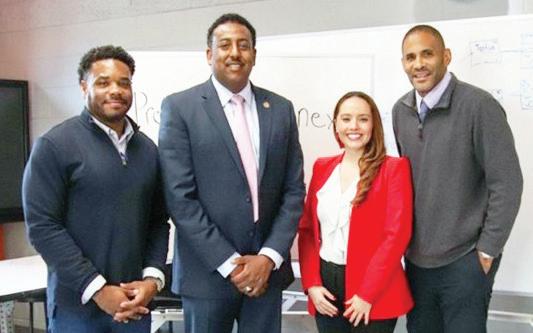
Former state Sen. Jeff Hayden (DFL-District 62) led the panel in exploring
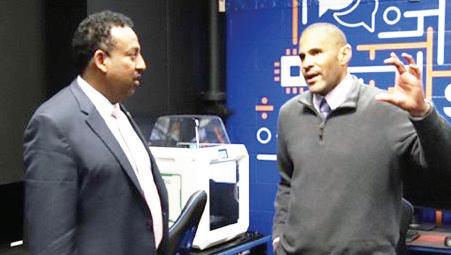
AI’s impact on underserved communities. The discussion centered on creating educational opportunities and applied programs to boost Minnesota’s economic competitiveness while supporting the long-term success of its diverse communities.
The group emphasized the urgent need to bridge digital divides.
“Understanding AI is essential for anyone entering the workforce in the coming
years,” Sanneh said, stressing the future link between AI literacy and career success. “AI is already transforming industries, and without a solid grasp of how it works, people risk being left behind.”
From a current legislative perspective, state Rep. Hussein (DFL-District 65A) highlighted AI’s importance for the Black community and other minority groups. He emphasized its potential to improve information access for younger generations, focusing on crucial aspects like early AI education. Given AI’s substantial economic impact on GDP, this approach would enable workforce participation and success.
As the next legislative session approaches, this timely panel underscores the importance of AI education in underserved communities. It highlights the need to address the growing equity gap in AI access and usage through increased investment in STEM programs
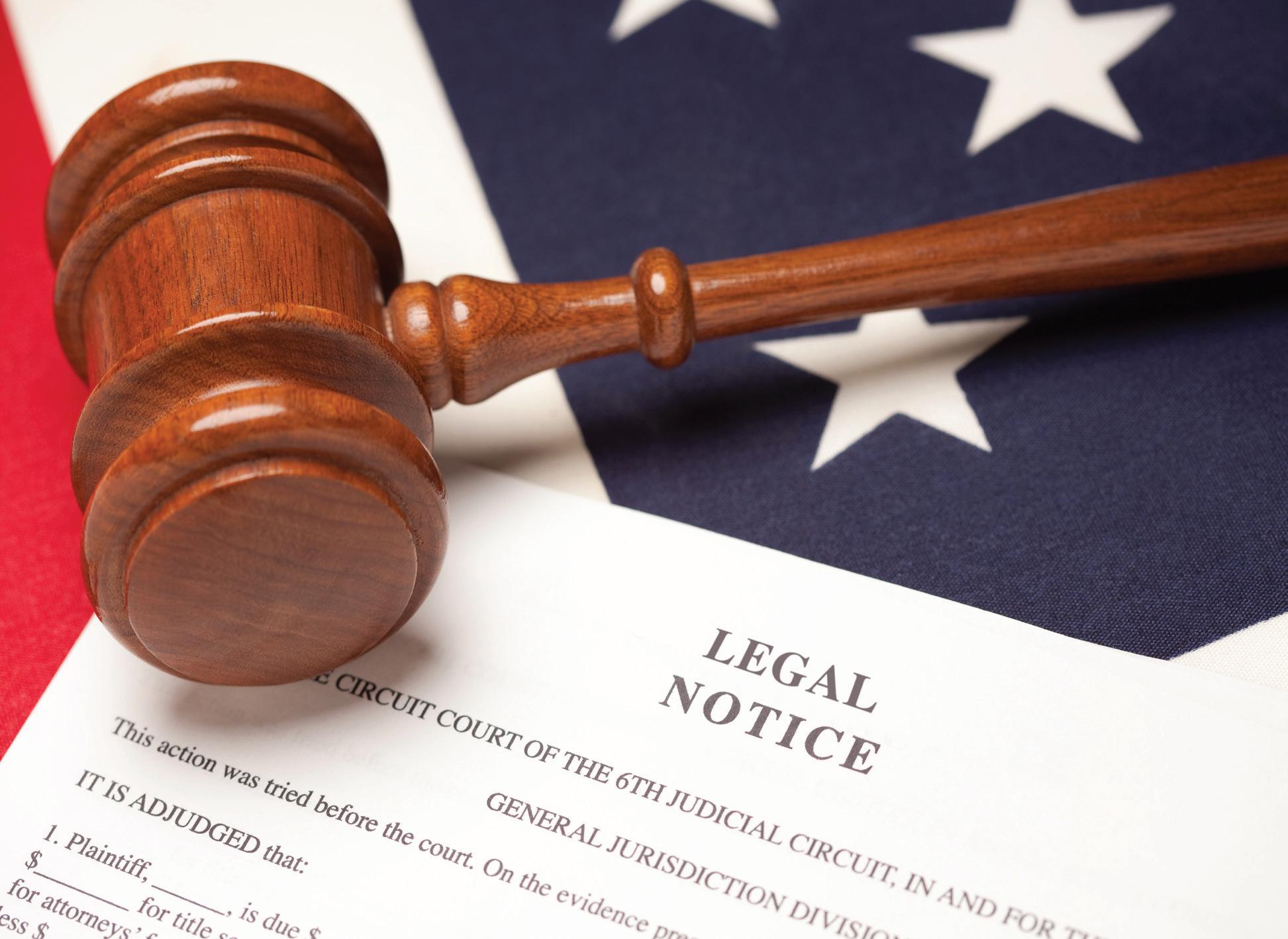


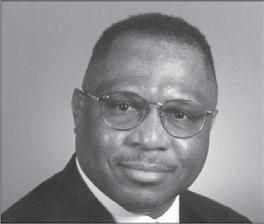

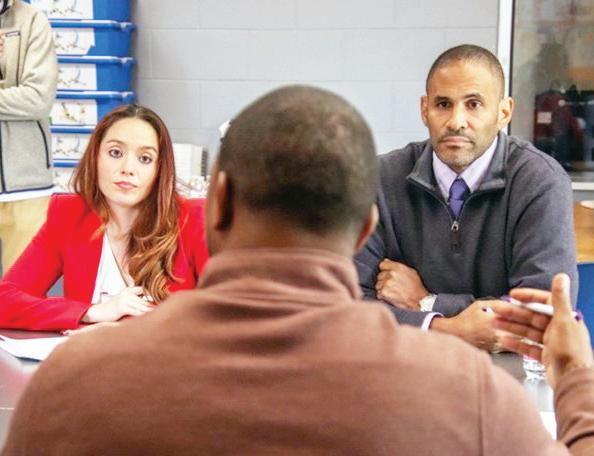
and new AI training opportunities. These initiatives will equip students with valuable, marketable skills for the future job market.
“We’re ensuring our kids don’t just learn about AI,” Sanneh explained. “They learn how to use it, adapt to it, and eventually lead in the tech space.” He further emphasized their goal to equip children with skills to innovate confidently using
AI, rather than merely consuming others’ work. This approach, he believes, positions them to become future leaders in their chosen industries. AI continues to shape the future of work, and initiatives like this panel discussion highlight ongoing efforts to ensure that all communities in Minnesota are prepared for the technological challenges and opportunities ahead.






As the Minnesota Spokesman-Recorder approaches its 90th anniversary, you’re invited to commemorate this historic milestone by donating $90 to celebrate 90 years of continuous publication.
As the Minneapolis Spokesman-Recorder begins its 90th Anniversary year, you’re invited to commemorate this historic milestone by donating $90 to celebrate 90 years of continuous publication.
Your generous contribution will support our legacy of dedicated community empowerment through journalism and ensure our vital work continues into the future.
As a “$90—for- 90” contributor (non-business), your name will be prominently displayed in our print and digital editions until the week of Aug. 10, 2025. The paper was founded on Aug. 10, 1934.
As a “$90-for-90” contributor (non-business), your name will be prominently displayed in our print and digital editions until the week of Aug. 10 — the date of our founding in 1934.
Please consider this unique opportunity to stand collectively with the MSR, honoring 90 years of tradition and community service. For inquiries or to join as a “$90-for-90” supporter, call 612-827-4021, visit our website, or email admin@spokesman-recorder.com.
Anita Alexander
Ray Seville Productions
Torrion Amie
Kimerlie Geraci
Holly Andersen
David Fettig
Nancy L. Beals
Tracy Wesley
Jonathan Beck
The O’Neill Family
Clara Boykin & Family
Liam Cavin
Gretchen Bratvold
Amanda Brinkman
Your Name Here
Toweya Brown-Ochs
Your Name Here
Benjamin F. Bryant & Dr. Antusa S. Bryant
Your Name Here
Deanna Callender
Your Name Here
Shirlee L. Callender
Your Name Here
Karl Cambronne
Your Name Here
Liam Cavin
Your Name Here
Janis Clay
Your Name Here
Edward Coblentz
Your Name Here
Coventry Cowens
Michael Davis
Your Name Here
Victoria Davis
Your Name Here
Michael Diehl
Your Name Here
April A. Estes
Your Name Here
George Ewing
Your Name Here
Elizabeth Fealey
Your Name Here
David Fettig
Your Name Here
Readus Fletcher
Your Name Here
Ken Foxworth
Your Name Here
Michael Franks
Your Name Here
Your Name Here
Lee Friedman
Ella Gates-Mahmoud
Your Name Here
Kimerlie Geraci
Your Name Here
Erick Goodlow
Your Name Here
Leota Goodney
Your Name Here
Ellen Guettler
Your Name Here
MRPP and Associate Communications
Your Name Here
Melanie Manaen
Kyle Meerkins
Your Name Here
Deborah Montgomery
Your Name Here
Debbie Morrison
Your Name Here
Marcia Murray
Your Name Here
Pamela Hall-Clemens
Your Name Here
Mary K. Murray Boyd
Your Name Here
Cyriaque Sukam
Timothy Sullivan
Your Name Here
Heidi Swank
Your Name Here
Dotty Timmons
Your Name Here
Nicholas Upton
Your Name Here
Jason Walker
Your Name Here
Dr. Betty Webb
Jeana Hamm
Your Name Here
Hendon Group, Inc
Your Name Here
Your Name Here
Dan Ness
Your Name Here
Sanda Noy
Your Name Here
Ellen Guettler & Ben Pofahl
Colnese Hendon
Your Name Here
Connie Hudson
Your Name Here
Angelo Hughes
Your Name Here
Andrew Issacson
Your Name Here
Katie Izzo
Your Name Here
Nina Johnson
Clarence Jones
Your Name Here
Debra Jones
Your Name Here
Shirley R. Jones
Your Name Here
Cynthia Kelly & Murry Kelly Jr.
Your Name Here
Nathaniel Khaliq
Your Name Here
Zena Kocher
Your Name Here
Jimmy Lewis
Your Name Here
Lisa Lissimore
Your Name Here
Michele Livingston
Harlan Luxenberg
Your Name Here
The O’Neill Family
Your Name Here
Minister Dr. Ni Ora Hokes
Your Name Here
Liz Oppenheimer & Jeanne Burns
Your Name Here
Ray Seville Productions
Your Name Here
Mary Quinn McCallum
Your Name Here
Amy Pfankuch
Your Name Here
Patty Ploetz
Your Name Here
Mark Ritchie
Your Name Here
Lyn Rabinovitch & John Saxhaug
Your Name Here
Augustus Ritemon
Your Name Here
Carolyn Roberson
Your Name Here
M. Rebecca Ross
Your Name Here
St. Paul Saints
Floyd Smaller
Your Name Here
Chanda Smith Baker
Your Name Here
South Hill Film
Your Name Here
Ronald Spika
Your Name Here
Bill Wells
Tracy Wesley
Your Name Here
Jeffery Young
Your Name Here
Your Name Here
Your Name Here
Your Name Here
Your Name Here
Your Name Here
Your Name Here
Your Name Here
Your Name Here
Your Name Here
Your Name Here
Your Name Here
Your Name Here
Your Name Here
Your Name Here
Your Name Here
Your Name Here
Your Name Here
Your Name Here
Your Name Here
Your Name Here
Your Name Here
Your Name Here
Your Name Here
Your Name Here
Your Name Here
Your Name Here
Your Name Here
Your Name Here
Your Name Here
Your Name Here
Your Name Here
Your Name Here
BUSINESS SYSTEMS ANALYST:
IT Company (Plymouth, MN) seeks Business Systems Analyst to utilize statistical and data analysis to implement security procedures, techniques, and remediation plans. Develop and maintain queries, reports, and metrics, to provide customized information for users to make business decisions. Conduct reviews of existing business & technical procedures to improve protections. Drive change and process improvements through metrics and analytics. Send resumes to: HRD, VITS Consulting Corp., 14264 23rd Ave N, Plymouth, MN 55447.
Minnesota Spokesman-Recorder October 17, 2024
BUSINESS SYSTEMS ANALYST:
IT Company (Plymouth, MN) seeks Business Systems Analyst to utilize statistical and data analysis to implement security procedures, techniques, and remediation plans. Develop and maintain queries, reports, and metrics, to provide customized information for users to make business decisions. Perform quality assurance and user acceptance testing for new developments meant to close security vulnerabilities in systems. Drive change and process improvements through metrics and analytics that will improve efficiencies and enable cost reductions. Send resumes to: HRD, VITS Consulting Corp., 14264 23rd Ave N, Plymouth, MN 55447. Minnesota Spokesman-Recorder October 17, 2024
Senior Clinical IT Developer for Medtronic, Inc.
Reporting to its facilities located at 710 Medtronic Parkway NE, Minneapolis, MN 55432. Duties: Provide technical expertise as part of the Statistical Programming (SP) group to develop and maintain programs and process methodology to meet internal and external clients’ needs related to medical device products. Requirements: Master’s degree in Biotechnology, Computer Science, Information Technology, Biostatistics, Statistics, or a related field. Requires two (2) years as an IT Developer or Clinical IT Developer or related occupation. Must possess at least two (2) years’ post-Bachelor’s experience with each of the following: Base SAS®; SAS/STAT, SAS/Macro, SAS/SQL, SAS/GRAPH, SAS/Access and SAS ODS; PC/UNIX SAS Environments; Working in a regulated medical device or pharmaceutical business; Coordinating trial analysis and Statistical Analysis Planning and Strategies; Preparing data for FDA regulatory submission; CDISC SDTM and ADAM Standards. Certification Requirements: Must be a Certified BASE SAS Programmer. Position is open to telecommuting from anywhere in the United States. Multiple positions available. To apply, visit https://medtronic.wd1.myworkdayjobs. com/MedtronicCareers/, select Req. R9119. No agencies or phone calls please. Medtronic is an equal opportunity employer committed to cultural diversity in the workplace. All individuals are encouraged to apply.
Minnesota Spokesman-Recorder October 17, 2024
Continued from page 12
New York took Game 2 on Sunday 80-66 to even the series at one game apiece. After Game 3, Game 4 is scheduled for Friday night also in downtown Minneapolis.
More diversity with expansion?
Last week the expansion Golden State franchise, which is scheduled to begin play next season, hired its first head coach, Natalie Nakase, the league’s first Asian HC. With still two openings to fill (Chicago and Los Angeles), and unless things don’t stay status quo, there will be only one Black head coach in the W (Seattle’s Noelle Quinn) next season.
At last week’s Finals press conference, the MSR asked Engelbert about the dwindling list of Black head coaches—two were fired in a two-week span during the playoffs—and if and when a
Continued from page 12
sudden resignation gave Jihad the opportunity to come full circle. Since North’s surprising state tournament appearance under Rowell’s leadership in 1976, the Polars have qualified in each decade since.
Black-led ownership group will get serious consideration for the next expansion team, which is expected to come on board in 2028.
“Obviously, we talk with our owners all the time about diversity in the coaching ranks, in their front office, back office, et cetera,” responded Engelbert. “We have a lot of assistant coaches that have been previous WNBA players and represent a very diverse group as well.
“We’re looking at it from all these angles, partnerships, ranks of our employee base, and certainly the coaching diversity and coaching as well,” concluded the commissioner. “It’s something that you can never rest on, so I appreciate the question. We’ll certainly be looking for our owners to have a diverse pool of candidates, and ultimately they’ll make the decision on their head coaches.”
Charles Hallman welcomes reader comments to challman@ spokesman-recorder.com.
From Ads Department/MN Spokesman-Recorder
PHONE: 612-827-4021
Mekdes Agegnehu Sisay, Plaintiff, vs. SUMMONS Radu Lungu, Defendant.
THIS SUMMONS IS DIRECTED TO the above-named Defendant:
FOR BILLING
INQUIRIES & TEARSHEETS
PLEASE CONTACT
L. Smith
I. YOU ARE BEING SUED. The Plaintiff has started a lawsuit against you. The Plaintiffs Complaint against you is attached to this summons. Do not throw these papers away. They are official papers that affect your rights. You must respond to this lawsuit even though it may not yet be filed with the Court and there may be no court file number on this summons.
ACCOUNTING DEPT
2. YOU MUST REPLY WITHIN 20 DAYS TO PROTECT YOUR RIGHTS. You must give or mail to the person who signed this summons a written response called an Answer within 20 days of the date on which you received this Summons. You must send a copy of your Answer to the person who signed this summons located at: Brantingham Law Office, P.A. 2200 E Franklin A venue, Suite 202 Minneapolis, MN 55404
BILLING@SPOKESMAN-RECORDER.COM
From Ads Department/MN Spokesman-Recorder
PHONE: 612-827-4021
NOTICE AND
FOR BILLING INQUIRIES & TEARSHEETS
PLEASE CONTACT ACCOUNTING DEPT @ BILLING@SPOKESMAN-RECORDER.COM
From Ads Department/MN Spokesman-Recorder
EMPLOYMENT DISPLAY
SIZE: 2 COL X 2 INCH
RATE $44.60 PER COL. INCH
PHONE: 612-827-4021
TOTAL: $178.40
3. YOU MUST RESPOND TO EACH CLAIM. The Answer is your written response to the Plaintiff’s Complaint. In your Answer you must state whether you agree or disagree with each paragraph of the Complaint. If you believe the Plaintiffs should not be given everything asked for in the Complaint, you must say so in your Answer.
FOR BILLING
INQUIRIES & TEARSHEETS
PLEASE CONTACT
ACCOUNTING DEPT
Please proof, respond with email confirmation to ad@ spokesman-recorder.com. For more exposure: We are also inviting our clients to advertise on our web site for 2 weeks for a flat fee of $150 per position with purchase of print ad.
4. YOU WILL LOSE YOUR CASE IF YOU DO NOT SEND A WRITTEN RESPONSE TO THE COMPLAINT TO THE PERSON WHO SIGNED THIS SUMMONS. If you do not Answer within 20 days, you will lose this case. You will not get to tell your side of the story, and the Court may decide against you and award the Plaintiff everything asked for in the Complaint. If you do not want to contest the claims stated in the Complaint, you do not need to respond. A default judgment can then be entered against you for the relief requested in the Complaint.
BILLING@SPOKESMAN-RECORDER.COM
SUMMONS 3 WEEK RUN FLAT RATE : $320
Please proof, respond with email confirmation to ads@spokesman-recorder.com
The MSR handles billing digitally. This means you will get e-tears and e-mailed invoices unless you specifically request a hard copy.
EMPLOYMENT DISPLAY
The MSR handles billing digitally. This means you will get e-tears and e-mailed invoices unless you specifically request a hard copy.
SIZE: 2 COL X 2.5 INCH
RATE $44.60 PER COL. INCH
From Ads Department/MN Spokesman-Recorder
5. LEGAL ASSISTANCE. You may wish to get legal help from a lawyer. If you do not have a lawyer, the Court Administrator may have information about places where you can get legal assistance. Even if you cannot get legal help, you must still provide a written Answer to protect your rights or you may lose the case.
TOTAL: $223.00
PHONE: 612-827-4021
6. ALTERNATIVE DISPUTE RESOLUTION. The parties may agree to or be ordered to participate in an alternative dispute resolution process under Rule 114 of the Minnesota General Rules of Practice. You must still send your written response to the Complaint even if you expect to use alternative means of resolving this dispute.
FOR BILLING INQUIRIES & TEARSHEETS
Dated: June 7, 2024
Please proof, respond with email confirmation to ad@ spokesman-recorder.com. For more exposure: We are also inviting our clients to advertise on our web site for 2 weeks for a flat fee of $150 per position with purchase of print ad.
BRANTINGHAM LAW OFFICE
PLEASE CONTACT ACCOUNTING DEPT
BILLING@SPOKESMAN-RECORDER.COM
The MSR handles billing digitally. This means you will get e-tears and e-mailed invoices unless you specifically request a hard copy.
Jeremy L. Brantingham, MN #0299558 2200 E. Franklin Avenue, Suite 202 Minneapolis, MN 55404 (612) 339-9700
ATTORNEY FOR PLAINTIFF
EMPLOYMENT DISPLAY
Minnesota Spokesman-Recorder
SIZE: 2 COL X 4 INCH
October 10, 17, 24, 2024
RATE $44.60 PER COL. INCH
TOTAL: $356.80
State of Minnesota Certificate of Assumed Name Minnesota Statutes Chapter 333
ASSUMED NAME: Todd M. Jackson
PRINCIPAL PLACE OF BUSINESS: Unit 491 6923 Angola Rd Holland, OH 43528 United States
NAMEHOLDER: Todd M. Jackson
Please proof, respond with email confirmation to ad@ spokesman-recorder.com. For more exposure: We are also inviting our clients to advertise on our web site for 2 weeks for a flat fee of $150 per position with purchase of print ad.
By typing my name, I, the undersigned, certify that I am signing this document as the person whose signature is required, or as agent of the person(s) whose signature would be required who has authorized me to sign this document on his/her behalf, or in both capacities. I further certify that I have completed all required fields, and that the information in this document is true and correct and in compliance with the applicable chapter of Minnesota Statutes. I understand that by signing this document I am subject to the penalties of perjury as set forth in Section 609.48 as if I had signed this document under oath.
The MSR handles billing digitally. This means you will get e-tears and e-mailed invoices unless you specifically request a hard copy.
AUTHORIZED REPRESENTATIVE AGENT
SIGNED BY:Todd-Michael:[JACKSON]
MAILING ADDRESS: UNIT 491 6923 ANGOLA RD HOLLAND OH 43528
EMAIL FOR OFFICIAL NOTICES: mddg1969@gmail.com
Minnesota Spokesman-Recorder October 10, 17, 2024
Continued from page 12
tournament in Woodson’s first two years in Bloomington. “We took a step backwards last year by not making the tournament, and that was disappointing,” noted the head coach. “We’ve got to move forward.”
head coach (Atlanta and New York Knicks). “It’s just the way sports look at [us]. There are a lot of Black coaches out there just as good. One day they hopefully will get a shot. I really believe that.”
Johnson pointed out that he hopes that Black coaches are hired “not in a lull in hiring. Hopefully people that make the hires understand that.
From Ads Department/MN Spokesman-Recorder
PHONE: 612-827-4021
Continued from page 12
FOR BILLING INQUIRIES & TEARSHEETS PLEASE CONTACT ACCOUNTING DEPT BILLING@SPOKESMAN-RECORDER.COM
spring and summer leagues.”
The PYFL playoffs and championship games are scheduled for Sunday, October 20, at the Minnesota Vikings’ Eagan practice facility. “That should be a great experience,” Elder surmised.
ASSUMED NAME FLAT RATE: $215.00 2 WEEK RUN
“It’s important for Minneapolis,” Reid told the MSR as he briefly reflected on the historic center where Prince once played. “I definitely know it can be something unique and special.”
Both Black coaches had player departures, now a regular staple in today’s transfer portal landscape. “It is challenging,” Woodson told me. Johnson added that it’s just the way it is and they must adjust accordingly.
Now Jihad is in a position to add to North’s legacy. If his past accomplishments are any indication of what the future holds, it’s looking bright for the Minneapolis North Polars.
Dr. Mitchell Palmer McDonald welcomes reader comments to mcdeezy05@gmail.com.
Queen ( 1980 , ’81, ’82, ’83, ’84, ’85, and ’86), Ingram (’90, ’ 95, ’96, ’97 , ’98 and ’99), McNeal (2002, ’ 03 ), and McKenzie (’ 16, ’17 , ’19, ’21, and ’22) followed the ’76 season combining for 20 more state tournament births and seven state championships (in bold).
And of course both coaches also realize that they are Black head coaches, and unfortunately sometimes undue and unrealistic criticism comes along with this, something that their non-Black counterparts don’t always face.
“I was in an environment in the NBA where we were fighting to get more Black head coaches,” recalled Woodson, who twice was a
“You know some guys are given an opportunity where it’s like hard to fail, and other guys are given an opportunity where it might be a harder place to win and not always penalized guys. Or guys that are given a second or third opportunity should not look a certain way.
“Hopefully other guys get the benefit of the doubt and that people [who hire] just do their homework when they hire. I think there’s a lot of capable [Black] coaches out there,” he concluded.
Charles Hallman welcomes reader comments to challman@ spokesman-recorder.com.
Sabathani court renovated Minnesota Timberwolves forward Naz Reid last week helped break in the newly renovated court at Sabathani Community Center in South Minneapolis. He was part of the October 9 ribbon cutting ceremony.
Please proof, respond with email confirmation ads@spokesman-recorder.com
Please Note: New email address for all ads is ads@spokesman-recorder.com
“We really wanted to give them the experience of being in a big venue, and kind of get a similar experience that kids not from this community get,” said Thomas.
The MSR handles billing digitally. This means you will get e-tears and e-mailed invoices unless you specifically request a copy.
Sabathani Chief Executive Officer and President Scott Redd pointed out that the investment by the Timberwolves and Lynx, along with U.S. Bank’s Our Courts, Our Future program, is well worth it. The court is the fifth indoor court renovation since the program’s inception in 2021.
“It gives youth a safe place to come and play, and also gives our seniors a place where they can grow old gracefully,” Redd said.
Charles Hallman welcomes reader comments to challman@ spokesman-recorder.com.
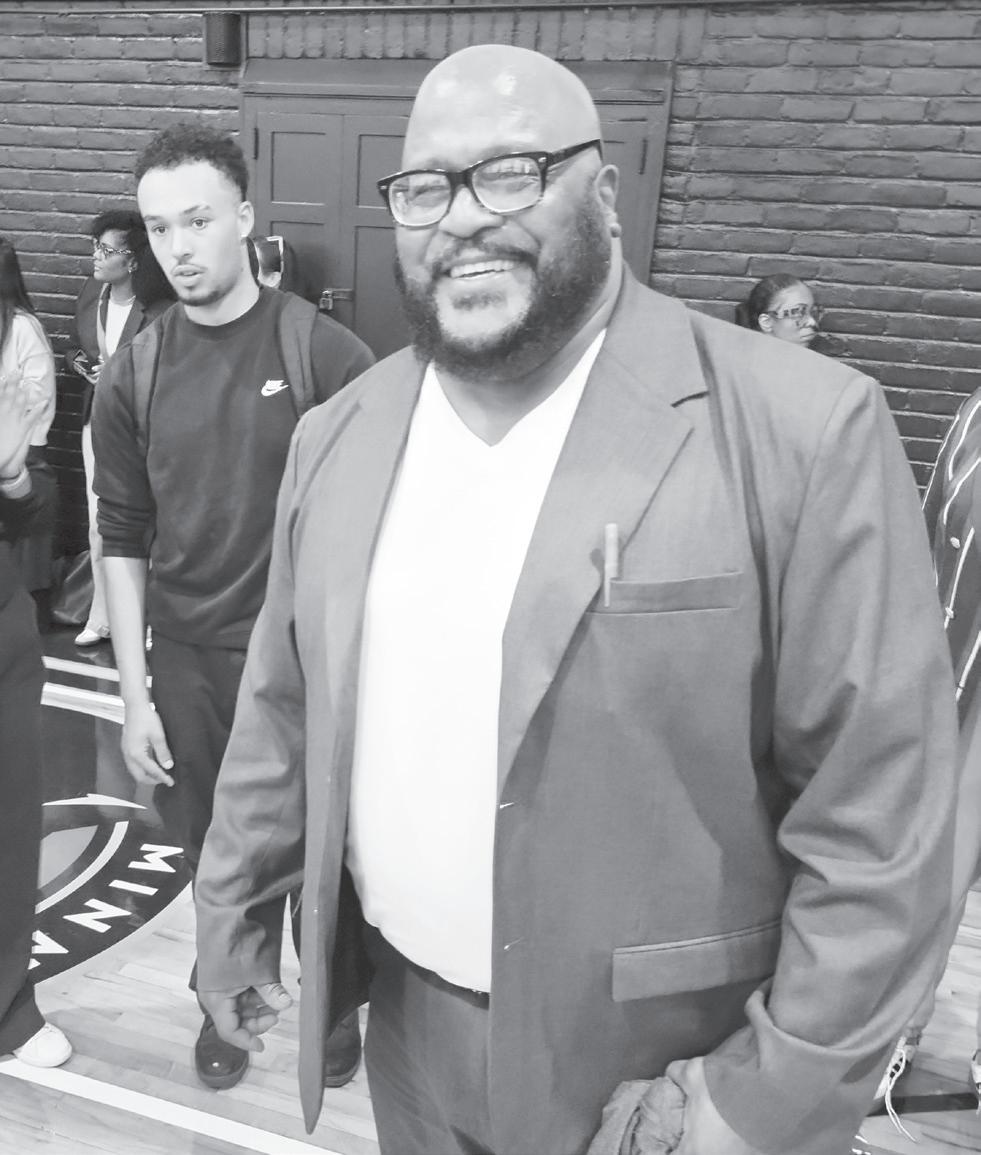
ame 3 of the 2024 WNBA Finals is Wednesday night in Minneapolis. No matter what happens, this Minnesota Lynx season will go into the record books as one of the historic ones in league and franchise history.
“They’re looking to become the second team in league history to sweep both the Commissioner’s Cup and the WNBA Finals trophy” in the same season, Commissioner Cathy Engelbert said last Thursday before Minnesota’s two-point overtime victory over New York Liberty.
“Obviously, we talk with our owners all the time about diversity in the coaching ranks, in their front office, back office,
It’s worth repeating just how much the Lynx’s comefrom-behind victory was an instant classic, one for the ages: First team in WNBA postseason history to win after trailing by 15+ points in the final five minutes of regulation, which broke a 0-183 streak by teams in such scenarios.
Minnesota tied the largest comeback in W Finals history after trailing by 18 points in the second quarter
2024 MVP runner-up Naphessa Collier set several historic marks, including the second player ever to record at least 17 points, seven rebounds and five blocks in a
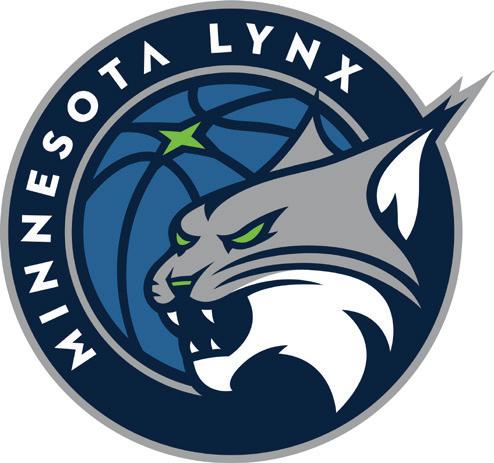
Finals game; and third player ever to record multiple playoff games of at least 17 points, seven rebounds and six blocks Collier joins Black WNBA legends Lisa Leslie and Candace Parker with her heroics.
“The Finals mark the culmination of what I think is the most transformational year in the WNBA’s history,” noted Engelbert of the best-of-5 championship series, which will be the last time in this format. Starting next season, the Finals will be best-of-7.
“The Finals will take on a 2-21-1-1 structure, in which the team with the higher seed will host Games 1, 2, 5 and 7, and its opponent will host Games 3, 4, and 6,” explained the Commish on the setup that most pro sports outside of football use to decide their league champions. “This will give our fans a championship series format that they are accustomed to seeing in other sports.
“We will also be changing our first round to a 1-1-1 setup for the best-of-three series,” she pointed out. “We have contemplated both these changes since the pandemic. We would have done it in the current year, but with the Olympic break this year it wasn’t possible.”
■ See SOE on page 11
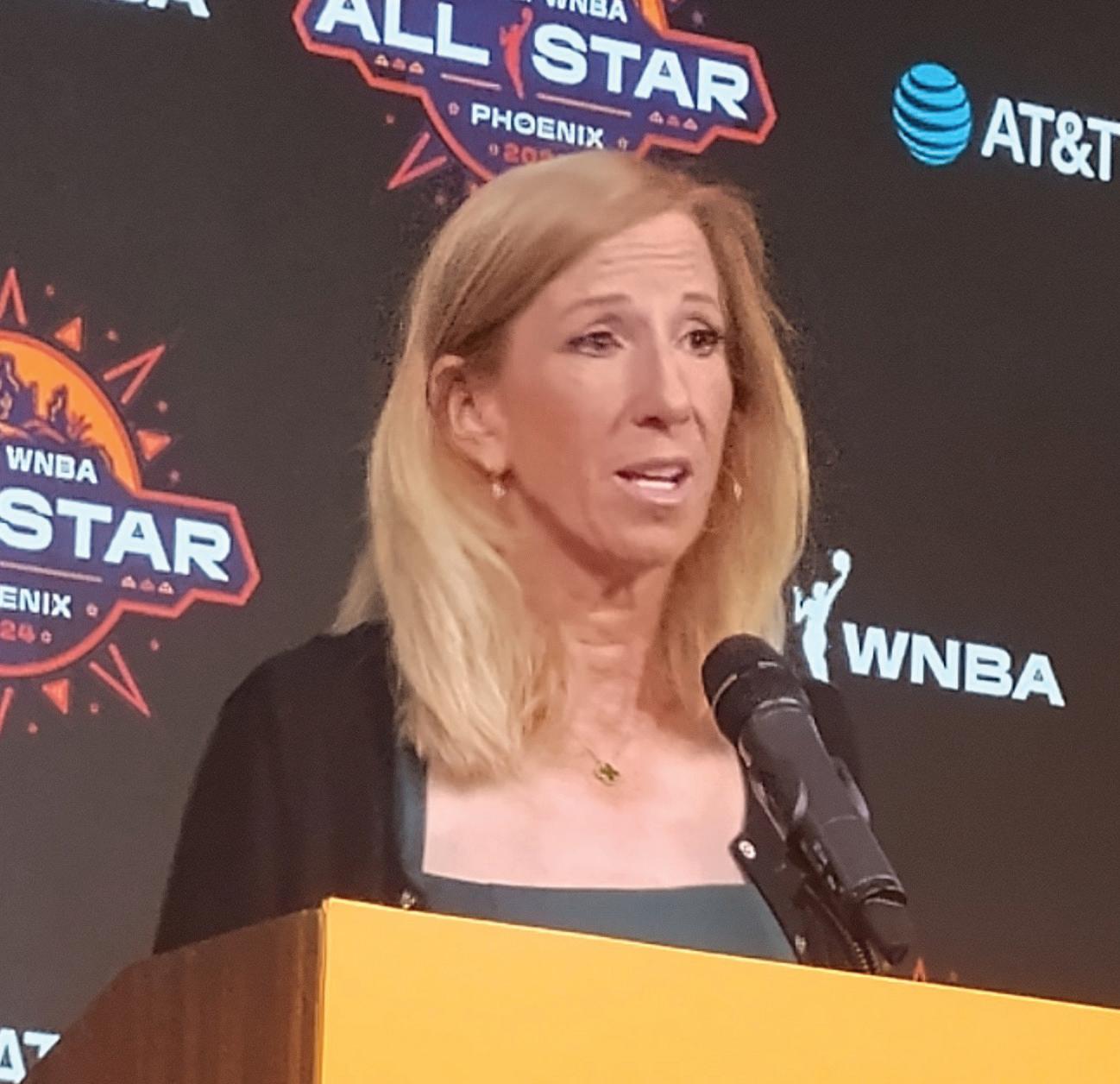

This occasional series will highlight Black coaches at all levels of sport. This week: Minnesota MBB Coach Ben Johnson and Indiana MBB Coach Mike Woodson
en Johnson is the first Minneapolis native to coach men’s basketball at the University of Minnesota. He cut his coaching teeth as an assistant coach at several schools, including his U of M alma mater, before getting his first head coaching opportunity in 2021, the same year Mike Woodson was hired at his alma mater Indiana University.
Both Johnson and Woodson begin their respective fourth seasons on the job this fall as the Big Ten’s only Black men’s basketball head coaches. We talked to both coaches in separate interviews during the recent Big Ten media days in
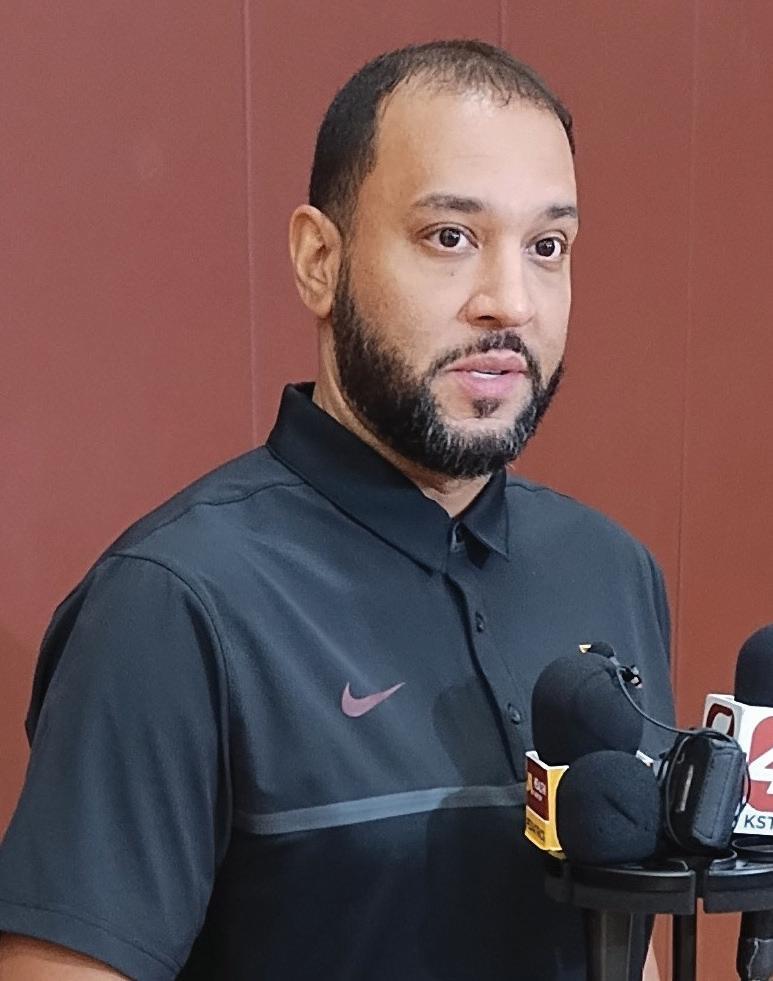
Chicago, and earlier talked to Johnson at the school’s practice facility on campus.
“There are a lot of Black coaches out there just as good. One day they hopefully will get a shot.”
“It’s me and Ben,” said Woodson matter-of-factly.
fourth season as
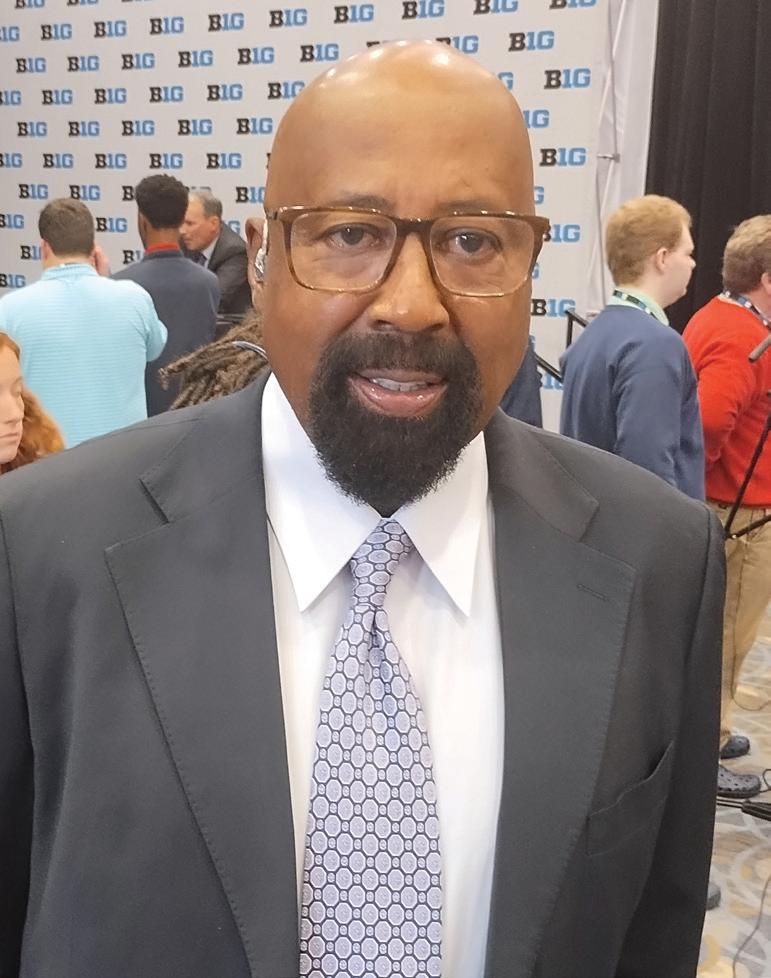
Gopher HC will see the opposing head coach also Black seven times at The Barn; two of them are HBCU coaches. The team returns five players from last season’s 19-15 squad, but only two starters. The Gophers were 16-4 at home, and its win improvement from the previous season was the best in the Big Ten and one of the best nationally among Power 5 schools.
“Their mindset has to be that, has to reflect that. They got to carry themselves in everything they do, as we’re building off last year even though we’re a new team.”
Woodson’s Hoosiers also look to improve this season after not making the NCAAs last season; they made the big
“I don’t want these guys to come here and not feel like they can’t win,” said Johnson to reporters, including the MSR prior to official practices last month. “To win nine league games, to win 19 games, to get in the postseason in the NIT and to win a game on the road, there’s a lot of winning that went into that.
Ahmil Jihad selected to lead Minneapolis
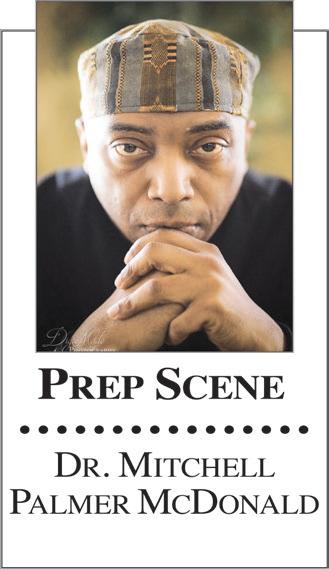
hmil Jihad is coming home!
A successful high school basketball coach for the past three decades and a 1984 Minneapolis North graduate, Jihad was recently selected to lead the boys program at his alma mater.
To say that Jihad is an accomplished coach on the basketball court is an understatement. His coaching resume includes years of coaching the STREETS and Howard Pulley AAU programs and seven years as an assistant for the bots program at Min -
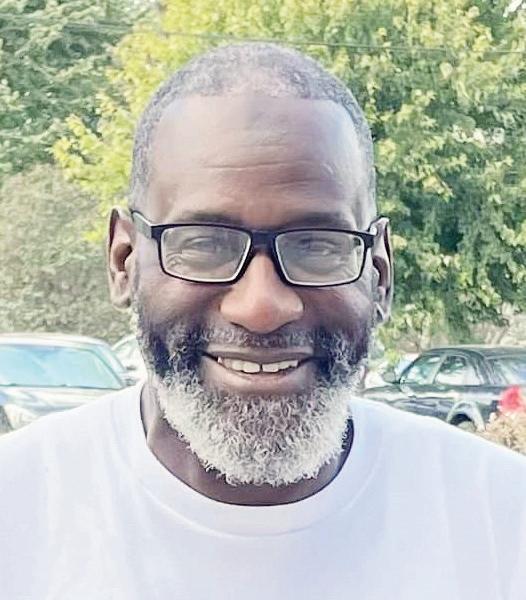
neapolis South. However, most remember his tenure as coach of the girls’ program at Minneapolis South during the mid-late 2000s.
During that time, he coached one of the state’s all-time greats in Tayler Hill—along with teammates Gabrielle Roberts, Sadiqah Jihad and
Tyisha Smith—culminating in a Class 4A state championship in 2009.
The University of Minnesota alum went on to revive the boys program at Minneapolis Edison, where he—with all-conference players Mohammed Mohamed, Johnny Spencer and Jabari Langley was named Minneapolis City Conference Coach of the Year in 2021. That was then! This is now! Jihad recently agreed to come back to his alma mater to lead one of the state’s premiere boys basketball programs. An educator in the St. Paul Public Schools since 1991, Jihad adds his name to a list of coaches—Alex Rowell, Tony Queen, Robin Ingram, Willie Jett, Brett McNeal, Broderick “Bo” Powell, Larry McKenzie, and Ricky Davis—all of whom have had successful tenures while leading the Polars. Davis led the Polars the past two seasons, and his
By Charles Hallman Sports Columnist
Around 200 urban kids ages 9 to 14 have been playing football for the past few weeks mainly on the North Side on Sunday midmornings.
“This is our Premier Youth Tackle Football League (PYFL),” explained Event Manager Taylor Elder prior to games at North High’s football field October 6. Says its website, PYFL’s mission “is to provide young athletes with opportunities to compete and win at some of the highest levels of youth football in an environment free from discrimination and prepare these athletes for lifelong contributions to society…”
My 7 on 7 owner/founder Ty Thomas pointed out, “I’m from South Minneapolis,” he said proudly. “I saw a necessity for the community. I felt I
could do it for the community.” Both Thomas and Elder noted it’s about more than just football. The participants get “a sense of culture and community around football,” said Thomas.
“What they get from it is life lessons. They get mentoring from good coaches, a safety net around these kids. There’s tons of things they get out of playing team sports, and they don’t have to travel to the suburbs and do it.
“We want something right here in the community,” added Thomas.
“It’s fun, something to do out of the house,” 11-year-old Kayden Walker said. His teammate, Roland Lester, also age 11, stressed, “I get to tackle, and also I get to have fun.” Walker and Lester are on the Minnesota Panthers, who played Twin Cities Hit & Stick
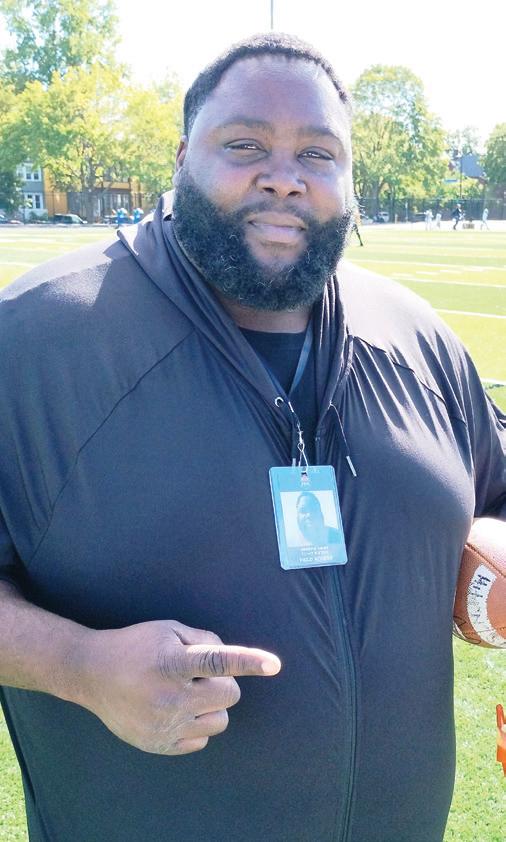

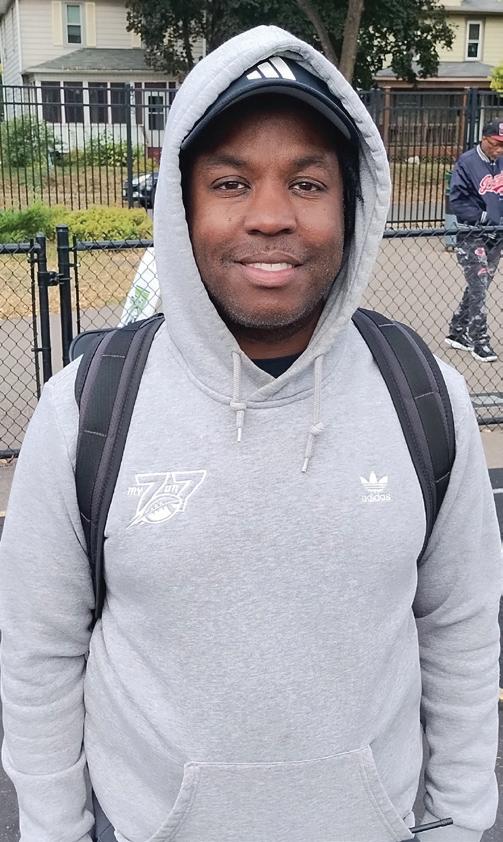

in the first of two scheduled games that Sunday morning at North High. The two teams played to a 6-6 tie.
“It was a good game, a defensive game,” said Joe Ames, who was waiting to play the
second game. He coaches the 12U Hit & Stick team.
“We are holding [games] in the inner city, where these kids want to be instead of being all the way in the suburbs, having to drive two, three
hours to play. We can keep the football right here in the inner city,” reiterated the coach. Elder described one of the reasons why he got involved with My 7 on 7 about a year ago: “I thought it was a great opportunity to help out the
youth sports community. So, I’ve given back to the community.”
“We run leagues year round,” stressed Thomas. We did a girls league this fall. Now we start ramping into our winter,